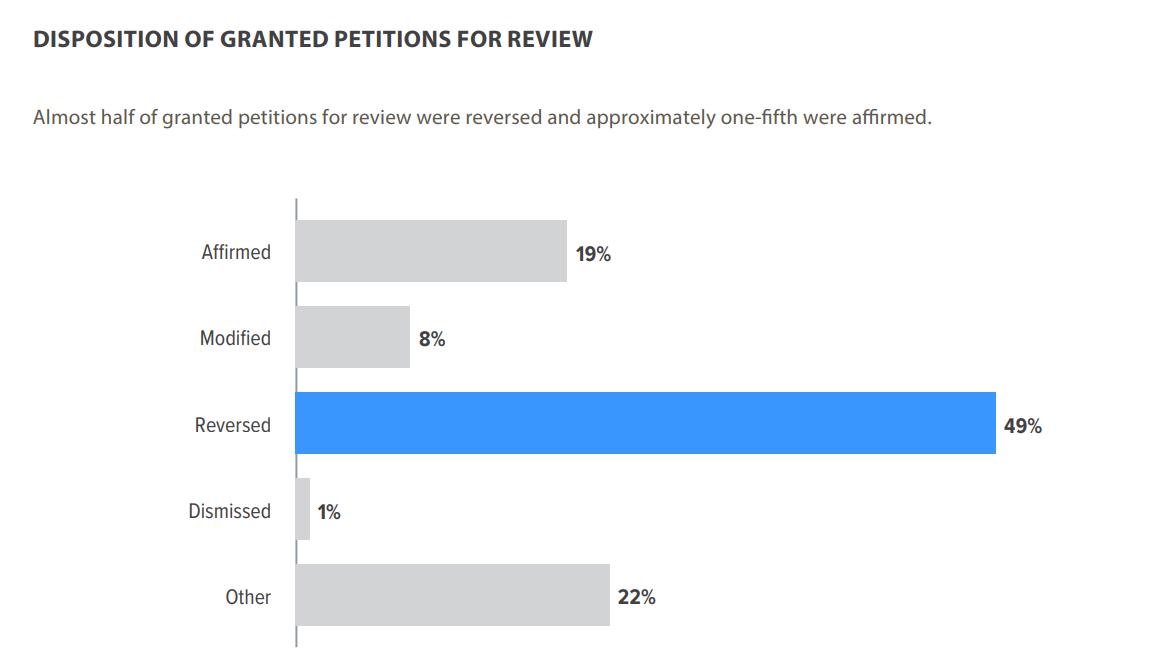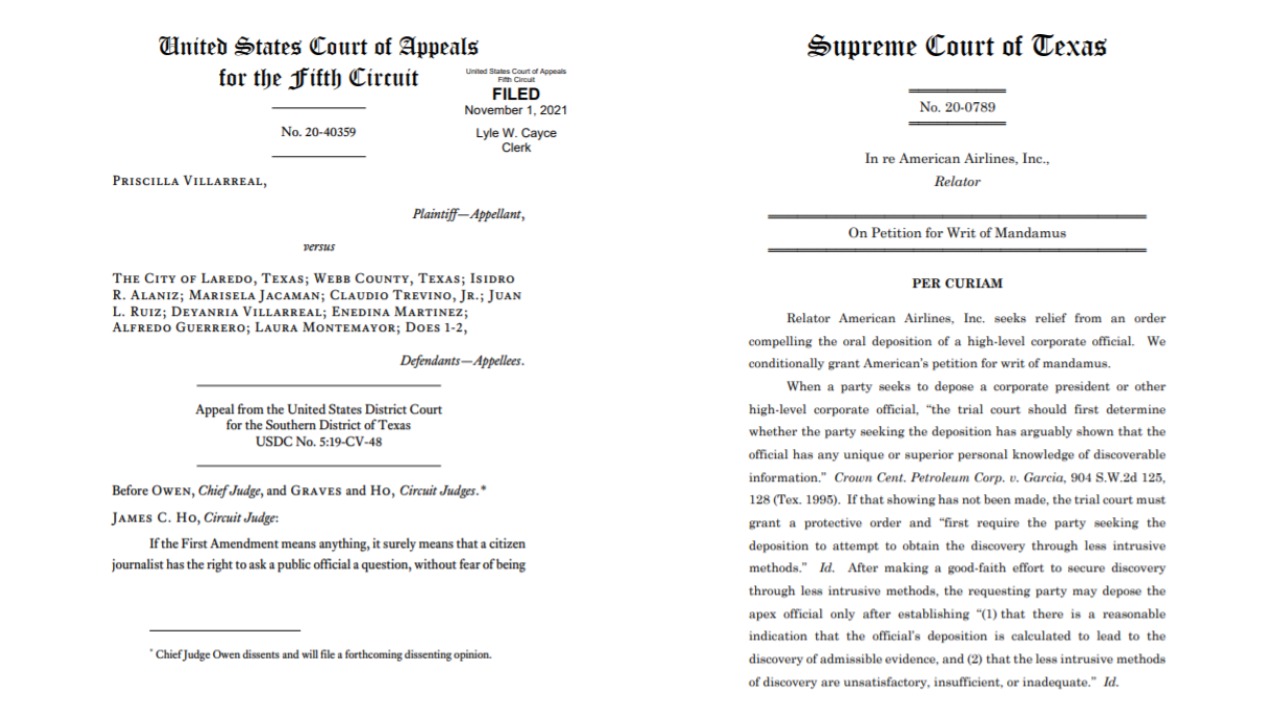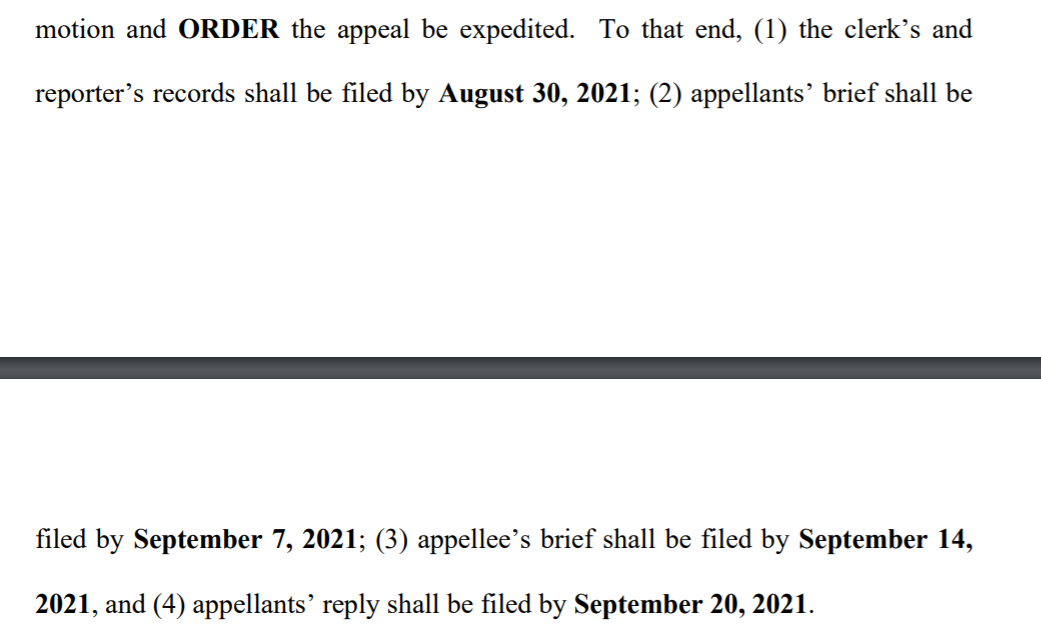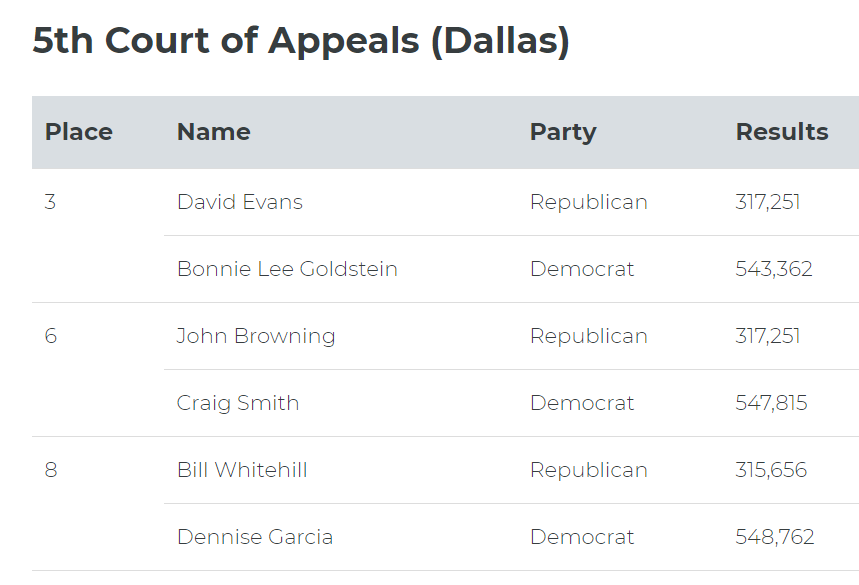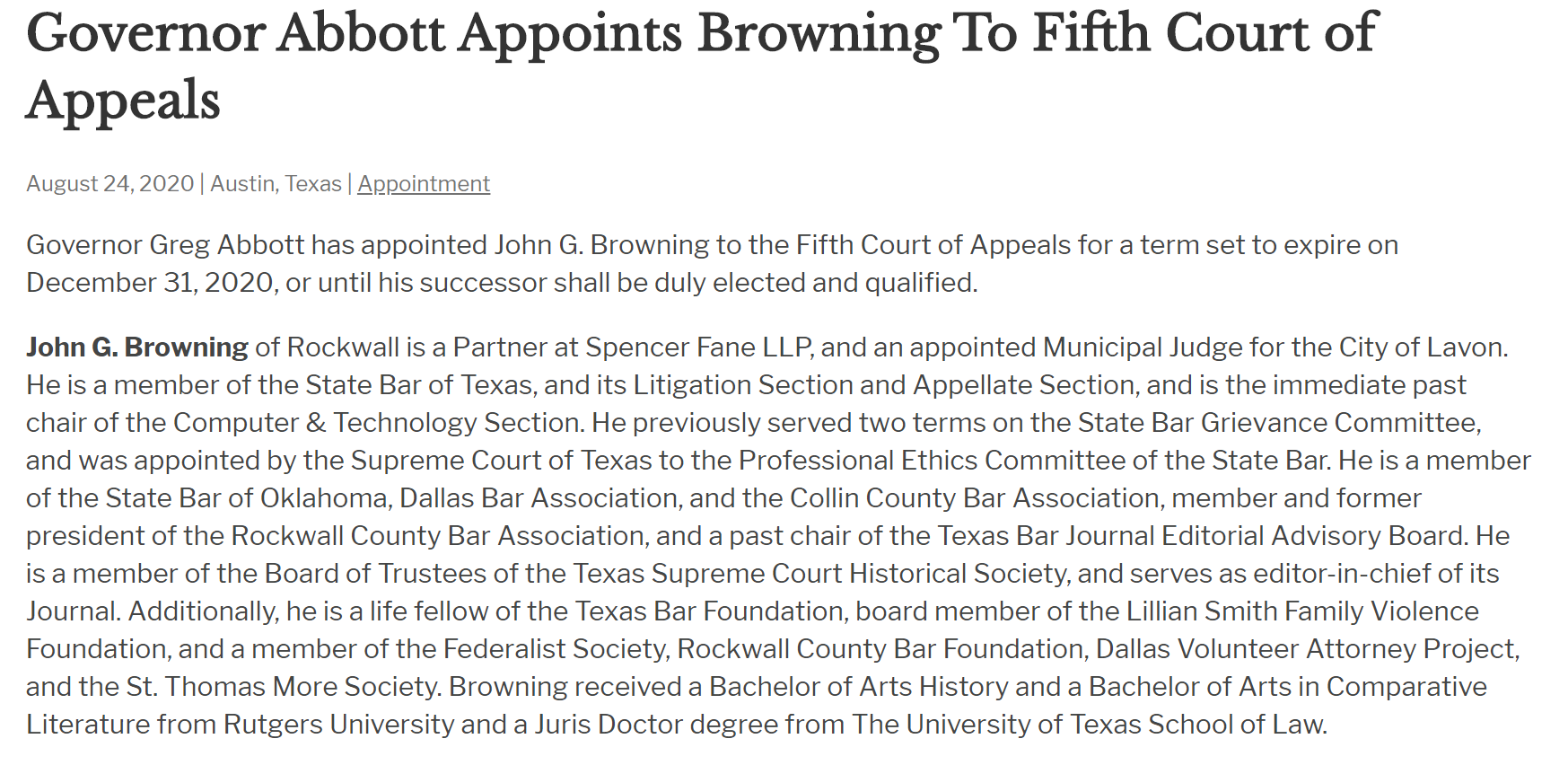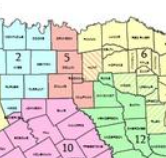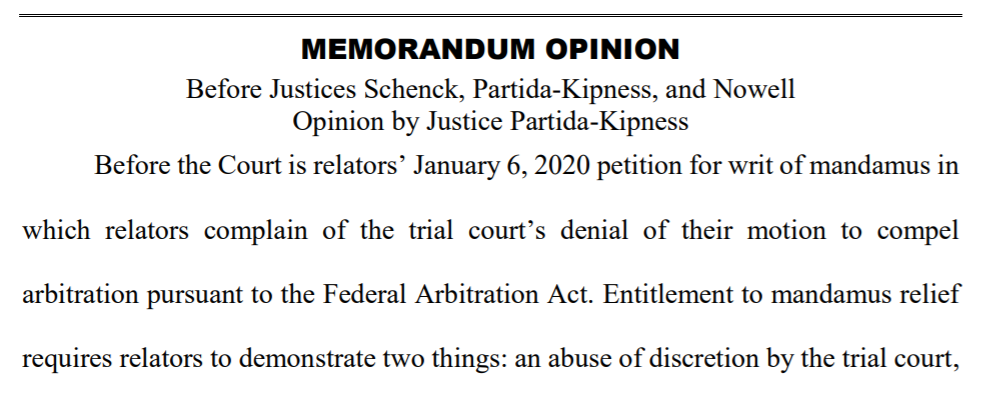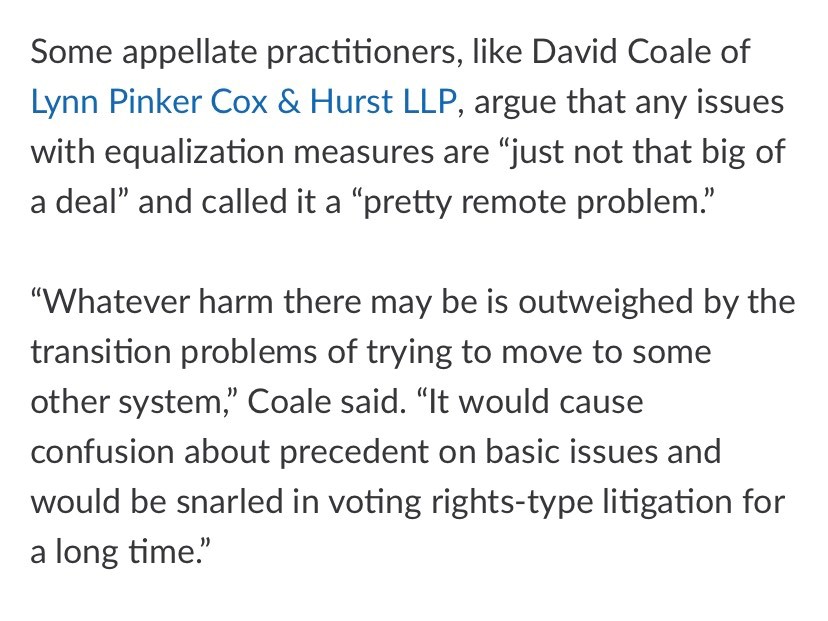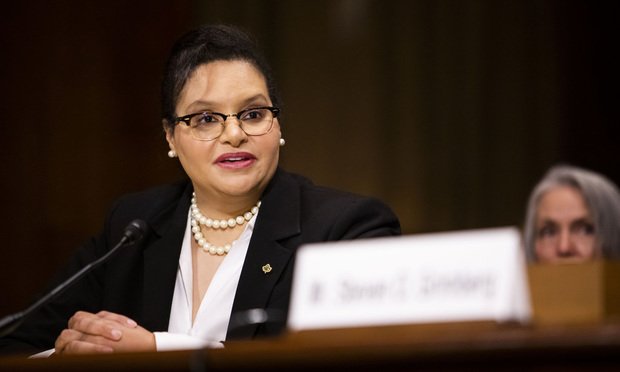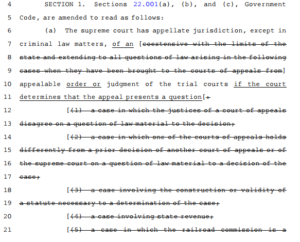Governor Abbott has made two appointments for the Texas Supreme Court after the recent retirement of Nathan Hecht–long serving Justice Blacklock becomes Chief, and the Governor’s general counsel becomes the newest Justice.
Category Archives: General Court Information
 2025 brings significant change to the Fifth Court, with J.J. Koch becoming Chief Justice, and Mike Lee, Jessica Lewis, Tina Clinton, Earl Jackson, Cynthia Barbare, and Gino Rossini joining as new Justices.
2025 brings significant change to the Fifth Court, with J.J. Koch becoming Chief Justice, and Mike Lee, Jessica Lewis, Tina Clinton, Earl Jackson, Cynthia Barbare, and Gino Rossini joining as new Justices.
As further detailed in today’s Texas Lawbook, Republicans did not completely sweep the eight races for positions on the Fifth Court. Mail-in and provisional ballots moved Hon. Tina Clinton into a lead over her Republican opponent.
Republican candidates swept the eight races for positions on the Fifth Court; the Texas Lawbook has a good summary.
The dispute about the execution of Robert Roberson reached the Texas Supreme Court late last week, producing a stay order until lower courts can evaluate the merits of the Legislature’s last-minute subpoena to Mr. Roberson. A concurrence, joined by three Justices, mused about the separation-of-power questions at issue. Despite the obvious merits of Mr. Roberson’s case, one does wonder what future mischief may be enabled by encouragement of assertive exercise of the Legislature’s subpoena power.
The Fifth Court of Appeals has open staff attorney positions. If you or someone you might recommend for employment is interested is pursuing such an opportunity, please click the link for additional information – Full-Time Central Staff Attorney
The supreme court is seeking comment on new rules about legal work by nonlawyers, designed to solve significant problems with access to justice. Justice Brett Busby recently provided some useful background about these important new measures.
 New TRAPs confirm that appellate filings need to include bookmarked .pdf files. A good practice anyway, the rules now make this practice an express requirement.
New TRAPs confirm that appellate filings need to include bookmarked .pdf files. A good practice anyway, the rules now make this practice an express requirement.
Hopefully the big water leak at 600 Commerce can be repaired soon and return the courthouse to normal operations.
The capable Doug Gladden posted this remarkable story on X about an appointed attorney in a criminal appeal who repeatedly recycles the same two, stale arguments — and explains why that practice has led to considerable injustice.
A long-anticipated constitutional challenge to the new Fifteenth Court of Appeals was recently filed by Dallas County, who was able to avoid some justiciability issues as the likely subject of a transfer order to that Court later this year.
The Fifth Court denied en banc review of Monticello Asset Managment v. Wells, a premises liability case involving a gruesome accident involving contact between a flagpole and an electric line. Four Justices joined a dissent to the denial of en banc review.
The most recent Advocate (the quarterly publication of the State Bar of Texas Litigation Section) has several articles about how the new Fifteenth Court of Appeals will get off the ground. I have a short piece on where the new court is likely to look for precedent, since it will have none of its own to start. I hope you find it useful in thinking about this important new appellate forum.
In November, the supreme court gave final approval to a new rule of procedure about permissive appeals. The key provision is as follows:
Below is a reminder email recently sent by the DBA Appellate Section about the annual joint Dallas-Tarrant meeting tomorrow (22nd), which will be at the Arts District Mansion and has lots of great material this year:
Greetings, colleagues! Welcome to your second-to-last reminder email about tomorrow‘s (September 22) Annual Joint Meeting with the Tarrant County Appellate Section. We’ve got some terrific speakers lined up for you, a fun reception afterwards (generously underwritten by Duane Morris LLP), and a bonus ethics CLE opportunity over the lunch hour by also attending the DBA’s Day of Civility luncheon.
As a bonus you don’t have to go far – this year’s meeting will be at the Dallas Arts Mansion. Yay!
Register here for the joint meeting:
Meeting Agenda:
8:00 am: Registration and continental breakfast
8:30 am: Practice and Procedure at the 5th Court of Appeals, presented by Justices Ken Molberg, Cory Carlyle, and Erin Nowell (Moderator: Anne Johnson)
9:45 am: Practice tips for success at the 2nd Court of Appeals, presented by Justices Elizabeth Kerr, Dana Womack, and Mike Wallach (Moderator: Chris Knight)
11:00 am: Supreme Court Q&A with Justices Jane Bland and Jimmy Blacklock
12:00 – 1:00: Lunch (Optional: Attend Day of Civility luncheon in adjoining room for additional 1.00 hour of CLE credit)
1:00 pm: The state of the Texas Judiciary with Chief Justice Nathan Hecht followed by a panel discussion with Chief Justices Hecht, Robert Burns, and John Bailey (Moderator: David Coale)
2:00 pm: Reception
Whether Texas needed a 15th Court of Appeals was (and on some points, continues to be) a matter of considerable debate. The supreme court’s recent opinion in In the Interest of AB and DB highlights another aspect of Texas’ intermediate court system that just hasn’t aged well.
Appeals from Gregg County proceed to both the Sixth and Twelfth Courts of Appeal; in that case, one parent appealed a parental-rights judgment to the Sixth Court, while the other appealed to the Twelfth. In the resulting confusion, the supreme court held that the father’s appeal was erroneously dismissed:
The Twelfth Court’s dismissal of the appeal upon Father’s motion did not divest the Sixth Court of jurisdiction. The Sixth Court concluded in error that the Twelfth Court’s dismissal fully adjudicated Father’s appeal. Rule of Appellate Procedure 42.1(a)(1) provides that an appellate court may not dismiss an appeal if “such disposition would prevent a party from seeking relief to which it would otherwise be entitled.” The Twelfth Court’s dismissal, which explicitly withheld adjudication under Rule 42.1(a)(1), was without prejudice to Father’s pursuit of his appellate rights in the Sixth Court. The Sixth Court improperly interpreted the dismissal as a final disposition preventing Father from seeking further relief in a court of appeals.
No. 22-0864 (Tex. Sept. 15, 2023) (per curiam).
This situation is relevant to Dallas because appeals from Hunt County (Greenville) alternate between Dallas and the Sixth Court. While the supreme court’s opinion capably reviews the applicable procedure, the more relevant question is why? It’s not readily apparent what benefit results from a system that can produce this kind of satellite proceeding.
In the latest Baylor Law Review, you can read an article that I co-wrote with the capable Ben Taylor called “Judgment Rendition in Texas” – here’s a link, and this is the abstract:
.
While In the Matter of J.W. involved an unusual problem–an Anders brief that, for the second time, appeared inadequate–it provided a reminder about a basic distinction that is sometimes overlooked. “Frivolity,” as to an appeal issue, is not the same as “reversibility”:
The two concepts are certainly not the same. An appeal is “wholly frivolous” or “without merit” when it “lacks any basis in law or fact.” Arguments are frivolous when they “cannot conceivably persuade the court.” An appeal is not wholly frivolous when it is based on “arguable” grounds. Reversal only occurs if arguable error is found to have occurred, and was harmful. . Many nonfrivolous arguments identify errors that do not result in reversal.
No. 05-22-00556-CV (Aug. 28, 2023) (mem. op.) (citations omitted).
The Appellate Section of the Dallas Bar Association recently sent around the following email, which I wanted to share more broadly, about two openings for briefing attorney positions at the Dallas Court of Appeals —
Colleagues:
Please see below for two appellate job openings that may be of interest.
https://jobs.dallasbar.org/jobs/view/staff-attorney/70601054/
Salary Range: up to $112,790.00
Location: Dallas, TX (hybrid, in-person and telework)
Position Available: Immediately
Justice Emily Miskel of the Court of Appeals, Fifth District of Texas, is accepting applications for a full-time, hybrid staff attorney position in her chambers. The Fifth District Court of Appeals has intermediate appellate jurisdiction of both civil and criminal cases appealed from the district and county courts in the counties that make up the Court’s District (Dallas, Collin, Kaufman, Rockwall, Grayson, and Hunt).
https://jobs.dallasbar.org/jobs/view/staff-attorney/70315081/
Salary Range: up to $112,790.00
Location: Dallas, TX (hybrid, in-person and telework)
Position Available: October 1, 2023
Justice Cory Carlyle of the Court of Appeals, Fifth District of Texas, is accepting applications for a full-time, hybrid staff attorney position in his chambers. The Fifth District Court of Appeals has intermediate appellate jurisdiction of both civil and criminal cases appealed from the district and county courts in the counties that make up the Court’s District (Dallas, Collin, Kaufman, Rockwall, Grayson, and Hunt).
Former Justice Lana Myers has been named as Lt. Gov. Dan Patrick’s counsel in connection with the upcoming impeachment proceedings of Ken Paxton.
I had an op-ed in today’s Dallas Morning News about recent friction between the Supreme Court and Fifth Circuit on standing in some high-profile constitutional/administrative-law cases.
After a well-publicized debacle in New York involving “research” in which ChatGPT invented nonexistent cases, the phenomenon of “hallucinatory” generative AI has arrived in Texas. The Waco Court of Appeals recently faulted a lawyer for providing a brief with three nonexistent cases (and, like the New York counsel, not responding when the problem was pointed out by the appellee). While there is nothing wrong with using ChatGPT to help with legal analysis and writing, uncritical acceptance of purported caselaw found “on the Internet” is always risky.
Two New York lawyers filed a brief with “fake law” in it, having accepted at face value a “hallucination” by ChatGPT abouot several cases that did not in fact exist. The district court has now sanctioned them. The opinion is of broad general interest, given the great influence of generative AI in its few short months of widespread public availability. And it’s also of broad general interest in avoiding sanctions–the lawyers had at least one good chance, and maybe even two, of coming clean about their error, but instead “doubled down” with purported screenshots of the nonexistent cases.
 Literature is filled with nonexistent books, such as the “Necronomicon” in the works of H.P. Lovecraft, the “Treatise on the Binomial Theorem” written by Sherlock Holmes’s menace, Professor James Moriarty, etc.
Literature is filled with nonexistent books, such as the “Necronomicon” in the works of H.P. Lovecraft, the “Treatise on the Binomial Theorem” written by Sherlock Holmes’s menace, Professor James Moriarty, etc.
To that collection, we can now add Varghese v. China South Airlines, Ltd., 925 F.3d 1339 (11th Cir. 2019).
ChatGPT helpfully offered that opinion to a New York lawyer researching a technical limitations issue. Unfortunately for that lawyer, the opinion did not actually exist and neither did any of the cases that it purported to cite. An understandably vexed federal judge is now considering sanctions about the matter.
Language-model AI tools are extraordinarily powerful and making advances every day. But they aren’t designed to do legal research, and anything they say about a specific precedent needs to be verified (and not by asking ChatGPT to verify itself, as happened in the federal case cited above).
In a dissent from a dismissal order in Chapman v. Doe, Justice Jackson questioned whether the Supreme Court had become too quick to vacate judgments, noting, inter alia, that “our common-law system assumes that judicial decisions are valuable and should not be cast aside lightly, especially because judicial precedents ‘are not merely the property of private litigants,’ but also belong to the public and ‘legal community as a whole.'” (reviewing United States v. Munsingwear, Inc., 340 U.S. 36 (1950)).
As she was the sole dissenter on this point, her views are apparently not shared by a majority of that court, but her analysis is still thought-provoking and deserves study, as it examines a part of the appellate process that often goes largely unnoticed. Thanks to Ben Taylor for drawing my attention to this one!
Justice Emily Miskel recently published a good article in Headnotes about recent appellate opinions involving issues with virtual trial proceedings. You can read the article on page 16 of the online publication or in this screenshot.
The supreme court is reviewing the Fifth Court’s case of Kansas City Southern Ry. v. Horton, a case that presents a mix of federal-preemption and Casteel issues. It will also review CAE SimuFlite v. Talavera, which presents a similar mix of substance (whether Texas recognizes a claim for educational malpractice) and procedure (Rule 91a’s proper role). The supreme court’s summary of issues appears here.
The supreme court has preliminarily approved this addition to the Tex. R. App. P. about the clerk’s record:
 Hopefully, this change will make it easier to follow Tex. R. App. 43.5 (and its supreme court analog), which says: “When a court of appeals affirms the trial court judgment, or modifies that judgment and renders judgment against the appellant, the court of appeals must render judgment against the sureties on the appellant’s supersedeas bond, if any, for the performance of the judgment and for any costs taxed against the appellant.”
Hopefully, this change will make it easier to follow Tex. R. App. 43.5 (and its supreme court analog), which says: “When a court of appeals affirms the trial court judgment, or modifies that judgment and renders judgment against the appellant, the court of appeals must render judgment against the sureties on the appellant’s supersedeas bond, if any, for the performance of the judgment and for any costs taxed against the appellant.”
 In re Torres granted relief in a failure-to-rule mandamus proceeding. The issue of the effect of COVID-19 came up in the Fifth Court’s review of the record, and the Court observed:
In re Torres granted relief in a failure-to-rule mandamus proceeding. The issue of the effect of COVID-19 came up in the Fifth Court’s review of the record, and the Court observed:
Although real parties Diaz and Galvan make the general claim that trial courts are facing staffing shortages and COVID-related delays, the record before this Court does not contain any indication that the COVID-19 pandemic has prevented the trial judge from ruling on the pending motion. … Indeed, as this Court has noted in a prior case, “courts across Texas—including this Court—have continued to fully tend to most business of the courts and serve the citizens of Texas while implementing safety precautions above and beyond recommendations by the Centers for Disease Control and Prevention and accommodating Covid-19-related exigencies.”
No. 05-22-00715-CV (Dec. 7, 2022) (mem. op.) (citations omitted).
 By close but decisive margins, Hon. Nancy Kennedy and Hon. Maricela Moore have won election to the Fifth Court. Congratulations to these two new Justices!
By close but decisive margins, Hon. Nancy Kennedy and Hon. Maricela Moore have won election to the Fifth Court. Congratulations to these two new Justices!
Hon. Erin Nowell and Hon. Amanda Reichek were unsuccessful in their races for the Texas Supreme Court, so their service on the Fifth Court will continue for the balance of their terms. The Texas Lawbook has a thorough review of other appellate elections around the state.
Depending on how quickly the Governor fills the vacancy created by the resignation of Hon. Leslie Osborne, the Court may briefly be all-Democrat – completing the reshaping that began with the 2018 election of the “Slate of Eight.”
A concurrence to the Texas Supreme Court’s denial of review in Lester v. Berg, No. 21-0775 (Nov. 4, 2022) reminded of the importance of following that court’s precedent (even while denying review of a court of appeals opinion that disagreed with it):
“It is fundamental to the very structure of our appellate system that this Court’s decisions be binding on the lower courts.” Dall. Area Rapid Transit v. Amalgamated Transit Union Local No. 1338, 273 S.W.3d 659, 666 (Tex. 2008). “[I]n reaching their conclusions, courts of appeals are not free to disregard pronouncements from this Court, as did the court of appeals here.” In re K.M.S., 91 S.W.3d 331, 331 (Tex. 2002) (citing Lofton v. Tex. Brine Corp., 777 S.W.2d 384, 386 (Tex. 1989) (“This court need not defend its opinions from criticism from courts of appeals; rather they must follow this court’s pronouncements.”)).
The Fifth Court’s recent opinion, In the Interest of CJP, makes a somewhat gloomy observation about a Texas Supreme Court decision to grant review, quoting the Texas Law Review‘s style manual: No. 05-22-00233-CV (Oct. 14, 2022) (mem. op.). The paper about internal operating procedure on the supreme court’s website paints a less-gloomy picture, however:
No. 05-22-00233-CV (Oct. 14, 2022) (mem. op.). The paper about internal operating procedure on the supreme court’s website paints a less-gloomy picture, however: As do the reversal statistics for 2021 available from the Office of Court Administration:
As do the reversal statistics for 2021 available from the Office of Court Administration:
The Texas Supreme Court has preliminarily approved a welcome new rule about the effect of requesting oral argument: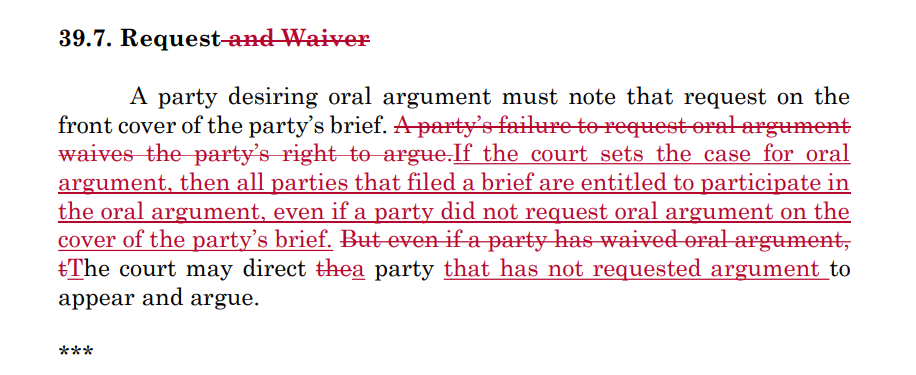
In a ruling that arose from an unusual joint mandamus petition, and drew significant amicus attention from trial-focused organizations, the Texas Supreme Court granted mandamus relief on October 7 as to an order requiring a virtual trial:
 An unusual feature of Texas’s Reconstruction-era constitution is that it places county prosecutors in the judicial branch of government rather than the executive. As a result, last December, the Court of Criminal Appeals found a law unconstitutional that attempted to give the Texas AG prosecutorial authority over certain Election Code violations. Last week that court denied rehearing – given the several individual opinions and extensive briefing in the matter, here is a link to the case generally, from which one can find the original opinion and the various documents related to rehearing.
An unusual feature of Texas’s Reconstruction-era constitution is that it places county prosecutors in the judicial branch of government rather than the executive. As a result, last December, the Court of Criminal Appeals found a law unconstitutional that attempted to give the Texas AG prosecutorial authority over certain Election Code violations. Last week that court denied rehearing – given the several individual opinions and extensive briefing in the matter, here is a link to the case generally, from which one can find the original opinion and the various documents related to rehearing.
 The supreme court has approved a new set of statewide rules about local court rules. A comment to new Tex. R. Civ. P. 3a summarizes their key features:
The supreme court has approved a new set of statewide rules about local court rules. A comment to new Tex. R. Civ. P. 3a summarizes their key features:
If you don’t subscribe to Jerry Bullard’s excellent updates about the Legislature’s activities relevant to appellate practice, you should. His most recent one advises of an upcoming House committee hearing about, inter alia, “potential solutions to improve the judicial efficiency of the state courts of appeals ….”
The well-known poem Antigonish begins:
Yesterday, upon the stair,
I met a man who wasn’t there
He wasn’t there again today
I wish, I wish he’d go away.
In that general spirit, in recent days, both the U.S. Court of Appeals for the Fifth Circuit and the Court of Appeals for the Fifth District at Dallas had close en banc votes involving questions of arbitrability, as to a party who “wasn’t there”–who had not signed an arbitration agreement, but was nevertheless potentially subject to it. (The Dallas case is discussed here; the Fifth Circuit’s, here.)
Whether the timing is an example of synchronicity I will leave to others. The courts’ difficulty with these issues shows the strong feelings provoked by the issue of court access, even among very sophisticated jurists, in an area of the law with well-developed case law on many key points.
 The en banc Fifth Court divided 7-6 on a difficult arbitration issue; specifically, whether a court or the AAA should resolve arbitrability as to wrongful-death claims brought by estate representatives. Agreeing with the panel majority, the full-court majority saw it as an issue for the AAA; the dissent, one for court. A concurrence urged consistency with applicable federal law. Prestonwood Tradition, LP v. Jennings, Nos. 05-20-00380 and -00387 et seq. (Aug. 5, 2022).
The en banc Fifth Court divided 7-6 on a difficult arbitration issue; specifically, whether a court or the AAA should resolve arbitrability as to wrongful-death claims brought by estate representatives. Agreeing with the panel majority, the full-court majority saw it as an issue for the AAA; the dissent, one for court. A concurrence urged consistency with applicable federal law. Prestonwood Tradition, LP v. Jennings, Nos. 05-20-00380 and -00387 et seq. (Aug. 5, 2022).
Justice Pedersen wrote the majority opinion, joined by Justices Myers, Schenck (who wrote a concurring opinion), Osborne, Reichek, Goldstein, and Smith. Justice Partida-Kipness wrote the dissent, joined by Chief Justice Burns and Justices Molberg, Nowell, Carlyle, and Garcia. The panel consisted of Justices Pedersen and Goldstein in the majority and Justice Partida-Kipness in dissent.
The Texas Supreme Court has now given final approval to some new Rules of Appellate Procedure about the identification and disclosure of counsel.
2 recent opinions state basic principles about stare decisis in Texas:
- The Texas Supreme Court expressly adopted the “rule of orderliness” concept in Mitschke v. Faiva, No. 21-0326 (May 13, 2022), observing: “If one appellate panel decides a case, and another panel of the same court differently resolves a materially indistinguishable question in contravention of a holding in the prior decision, the second panel has violated the foundational rule of stare decisis. Affording stare decisis authority to the second case would be tantamount to eliminating stare decisis altogether, as nothing would stop a third panel from returning to the initial outcome, or going yet another way.”
- A recent concurrence by Justice Schenck reminded: “I will … simply note that under the doctrine of stare decisis courts are bound only by the holding and discussion necessary to the resolution of the case. Newman v. Minyard Food Stores, Inc., 601 S.W.2d 754, 756 (Tex. App.—Dallas 1980, writ ref’d n.r.e.).”
 After a powerful summary of Texas’s constitutional protection for court access and jury trial, the en banc court in Maypole v. Acadian Ambulance Service reversed the dismissal of a medical malpractice claim for alleged shortcomings in the required medical authorization form. A concurrence agreed with the result but not the scope of the majority opinion. No. 05-18-00539-CV (June 10, 2022) (Hat tip to 600Commerce friend Ben Taylor for pointing this case out to me).
After a powerful summary of Texas’s constitutional protection for court access and jury trial, the en banc court in Maypole v. Acadian Ambulance Service reversed the dismissal of a medical malpractice claim for alleged shortcomings in the required medical authorization form. A concurrence agreed with the result but not the scope of the majority opinion. No. 05-18-00539-CV (June 10, 2022) (Hat tip to 600Commerce friend Ben Taylor for pointing this case out to me).
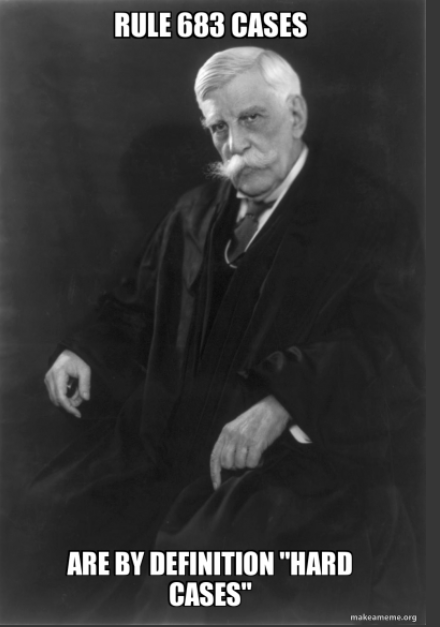 Justice Oliver Wendell Holmes, dissenting from an early Sherman Act case, famously observed: “Great cases like hard cases make bad law. For great cases are called great, not by reason of their importance… but because of some accident of immediate overwhelming interest which appeals to the feelings and distorts the judgment.” Northern Securities Co. v. United States, 193 U.S. 197 (1904).
Justice Oliver Wendell Holmes, dissenting from an early Sherman Act case, famously observed: “Great cases like hard cases make bad law. For great cases are called great, not by reason of their importance… but because of some accident of immediate overwhelming interest which appeals to the feelings and distorts the judgment.” Northern Securities Co. v. United States, 193 U.S. 197 (1904).
Yet in the context of temporary injunctions and TROs, there are only “hard cases,” because of the demanding requirements about proof of irreparable injury, etc. For example, the most recent statement from the Texas Supreme Court about the specificity required by Tex. R. Civ. P. 683 is In re: Luther, 620 S.W.3d 715, 722-23 (Tex. 2021) (orig. proceeding)–an extremely charged case politically, arising in one of the most challenging periods of the COVID-19 pandemic.
In that vein is the panel majority in In re Childrens Medical Center of Dallas, a dispute about care for transgender youth, which found this order sufficiently specific as to Rule 683’s requirements about harm. A dissent saw otherwise. No. 05-22-00459-CV (May 18, 2022) (mem. op.).
Of general interest to court-watchers, building on a recent interview that I did with the Lincoln Project, the current episode of the “Coale Mind” podcast examines why today’s Supreme Court is like a bowl of soup, heated by two separate burners.
The first is the ongoing scrutiny over Justice Thomas’s recusal decisions in matters related to his wife’s political activity. The second, cool now but with the potential to become blazing hot, is the pending Dobbs case in which the Court could significantly limit or even overrule Roe v. Wade.
The combined heat potentially generated by these two issues–an ethical dispute about a Justice coupled with the possibility of a uniquely controversial ruling–could present a legitimacy problem for the Court of a magnitude not seen in recent memory.
The Fifth Court’s recent ERCOT opinion found that matter appropriate for en banc review when, between its original panel opinion and the present proceedings, the Texas Supreme Court had ruled on immunity issues in a way that undermined a key assumption of the panel opinion about ERCOT’s immunity. (“In the most recent of these three opinions, the supreme court stated: ‘Though we have contemplated it, we have yet to extend sovereign immunity to a purely private entity—one neither created nor chartered by the government—even when that entity performs some governmental functions.'”).
At least nominally, that analysis puts the case in the “just right” category of my Goldilocks article about intermediate-court en banc review, although the importance of the subject matter may make it a “big splash” case as well.
 The ERCOT dissent suggests another, fragrance-based approach to decisions about en banc review: “To be clearly erroneous, a decision must strike us as more than just maybe or probably wrong, it must . . . strike us as wrong with the force of a five-week old, unrefrigerated dead fish.” (citing Parts & Elec. Motors, Inc. v. Sterling Elec., Inc., 866 F.2d 228, 233 (7th Cir. 1988).
The ERCOT dissent suggests another, fragrance-based approach to decisions about en banc review: “To be clearly erroneous, a decision must strike us as more than just maybe or probably wrong, it must . . . strike us as wrong with the force of a five-week old, unrefrigerated dead fish.” (citing Parts & Elec. Motors, Inc. v. Sterling Elec., Inc., 866 F.2d 228, 233 (7th Cir. 1988).
A new set of TRAPs about direct appeals to the Texas Supreme Court takes effect at the start of 2022. It substantially clarifies the procedure for these unusual cases, and aligns the rules about them with other TRAPs about supreme-court proceedings.
I recently wrote an article, “Federalism and Appellate Procedure: Five Texas-Federal Differences to Know,” in the Appellate Advocate, the quarterly publication by the Appellate Section of the State Bar of Texas. I hope you find it interesting and useful.
The original incarnation of the TCPA was widely criticized for broad language that included a wide range of civil litigation. After its amendment, opinions such as CBS Stations Group v. Burns remind that, at its core, the TCPA serves an important role in protecting First Amendment rights; here, a local TV station’s coverage of a bank robbery:
“We conclude Burns failed to present clear and specific evidence that CBS knew or should have known that publication of the photograph in connection with the report on the robbery was false. Further, there is no evidence supporting a conclusion that a photograph obtained from a law enforcement agency after a public–information-act request using the correct name and birth date of the individual would warn a reasonably prudent broadcaster of its defamatory potential.”
No. 05-21-00042-CV (Sept. 27, 2021) (mem. op.). Of special note, the panel includes Justice Ken Molberg, author of Dyer v. Medoc Health Services, 573 S.W.3d 418 (Tex. App.–Dallas 2019, pet denied), which thoroughly reviewed and significantly limited the TCPA’s protection of the right of association, compared to some earlier opinions by other courts of appeal on the topic.
An en banc majority opinion, overruling prior case law to the contrary, held “that the plaintiff must meet its initial burden on a special appearance by pleading, in its petition, sufficient allegations to invoke jurisdiction under the Texas long-arm statute.” (emphasis in original). (Relatedly, under the relevant supreme court precedent, “[t]he plaintiff’s response to the special appearance may contain evidence supporting the petition’s jurisdictional allegations, but that evidence must be consistent with the allegations in the petition.”) Steward Health Care System LLC v. Saidara, No. 05-19-00274-CV (Aug. 20, 2021). Other opinions were written.
Relying on my fortune-telling skills (right) , I offer these thoughts on the recent Texas Supreme Court orders in the ongoing mask litigation:
, I offer these thoughts on the recent Texas Supreme Court orders in the ongoing mask litigation:
- The court could have effectively ended the litigation with a complete stay, as it did last week in the “arrest the legislators” case.
- It didn’t do that. Instead, it let temporary injunction hearings go forward in both Bexar and Dallas Counties. The Bexar hearing is today.
- A decent guess is that there is division of opinion on the court and this order is a rough compromise, among: (a) Justices who would have ruled for the Governor (who “got something” in the form of the initial TROs being vacated; (b) Justices who want to further consider the evidence (or lack thereof) (and who “got something” by the TI hearings proceeding; and (c) Justices who were willing to “kick the can down the road” until after the TI hearings.
An old lawyers’ adage, sometimes attributed to Carl Sandburg, says in part: “If the facts are against you, argue the law. If the law is against you, argue the facts. …” Such are the battle lines in the Dallas County mask-mandate case now before the supreme court, in which the real-party-in-interest county judge points to an extensive affidavit and the support of several amici, while the SG’s office laser-focuses on the terms of the Government Code.
Clay Jenkins has filed his response to the AG’s mandamus petition to the Fifth Court of Appeals.
- In 2019, Bombardier Aerospace Corp. v. SPEP Aircraft Holdings holds that the written word matters: “Under our strongly held principles of freedom to contract, we hold that the limitation-of-liability clauses are valid limited warranties that were the basis of the parties’ bargain. … Although Bombardier’s conduct in failing to provide SPEP and PE with the new engines they bargained for was reprehensible, the parties bargained to limit punitive damages, and we must hold them to that bargain.”
- In 2020, Energy Transfer v. Enterprise emphasized that the written word matters: “We hold that parties can conclusively negate the formation of a partnership under Chapter 152 of the TBOC through contractual conditions precedent. ETP and Enterprise did so as a matter of law here, and there is no evidence that Enterprise waived the conditions.”
- During 2021, in In re the Estate of Johnson, the Court noted that actions also matter: “MacNerland was put to an election: either seek to set the will aside or accept the benefits Johnson bequeathed to her. She chose the latter. As a result, she ‘must adopt the whole contents of the instrument, so far as it concerns [her], conforming to its provisions, and renouncing every right inconsistent with it.’ Because MacNerland accepted benefits under Johnson’s will, the trial court properly dismissed her challenge to its validity.” (citation omitted).
- But last week, in BPX Operating v. Strickhausen, the Court again gave primacy to the written word: “Strickhausen bargained for a strong anti-pooling clause, she consistently withheld the written consent the clause requires, and she reiterated her objections multiple times. Although she accepted BPX’s money, she reasonably believed that one way or another she was owed an amount in the same ballpark as the checks she deposited.”
With respect to court orders and judgments, the words “signed,” “rendered,” and “entered” are often used interchangeably. But those words have specific, technical meanings, and it is wise to remember those meanings when differences matter. Accord, Burrell v. Cornelius, 570 S.W.2d 382, 384 (Tex. 1978) (“Judges render judgment; clerks enter them on the minutes. … The entry of a judgment is the clerk’s record in the minutes of the court. ‘Entered’ is synonymous with neither ‘Signed’ nor ‘Rendered.’”).
Two rules set the background as to when critical countdowns commence:
- Tex. R. Civ. P. 306a: “The date of judgment or order is signed as shown of record shall determine the beginning of the periods prescribed by these rules for the court’s plenary power to grant a new trial or to vacate, modify, correct or reform a judgment or order and for filing in the trial court the various documents that these rules authorize a party to file …”
- Similarly, Tex. R. App. P. 26.1 begins: “The notice of appeal must be filed within 30 days after the judgment is signed, except as follows …”
By contrast, “[j]udgment is rendered when the trial court officially announces its decision in open court or by written memorandum filed with the clerk.” E.g., S&A Restaurant Corp. v. Leal, 892 S.W.2d 855, 857 (Tex. 1995) (per curiam). And the above-quoted paragraph from Rule 306a concludes: “… but this rule shall not determine what constitutes rendition of a judgment or order for any other purpose.”
By contrast, entry of judgment refers to the recording of a rendered judgment in the court’s official records. See, e.g., Lone Star Cement Corp v. Fair, 467 S.W.2d 402, 405 (Tex. 1971) (“The law is settled in this state that clerical errors in the entry of a judgment, previously rendered, may be corrected after the end of the court’s term by a nunc pro tunc judgment; however, judicial errors in the previously rendered judgment may not be so corrected.” (emphasis added)).
I gratefully acknowledge the excellent insights of Ben Taylor in preparing this post!
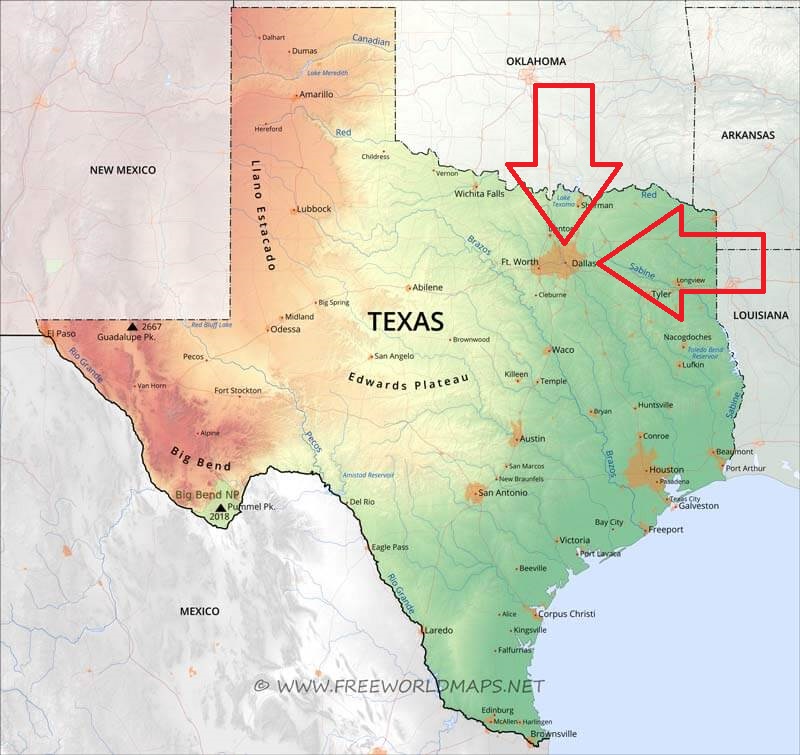 Dallas-Fort Worth is the fourth largest metropolitan area in the United States, and it is only a matter of time until it passes Chicago to become #3. Dallas is routinely ranked among the nation’s best cities. Yet it is significantly underrepresented on the Texas Supreme Court. Hopefully, geographic diversity will play a role in the appointment of a successor to Justice Eva Guzman.
Dallas-Fort Worth is the fourth largest metropolitan area in the United States, and it is only a matter of time until it passes Chicago to become #3. Dallas is routinely ranked among the nation’s best cities. Yet it is significantly underrepresented on the Texas Supreme Court. Hopefully, geographic diversity will play a role in the appointment of a successor to Justice Eva Guzman.
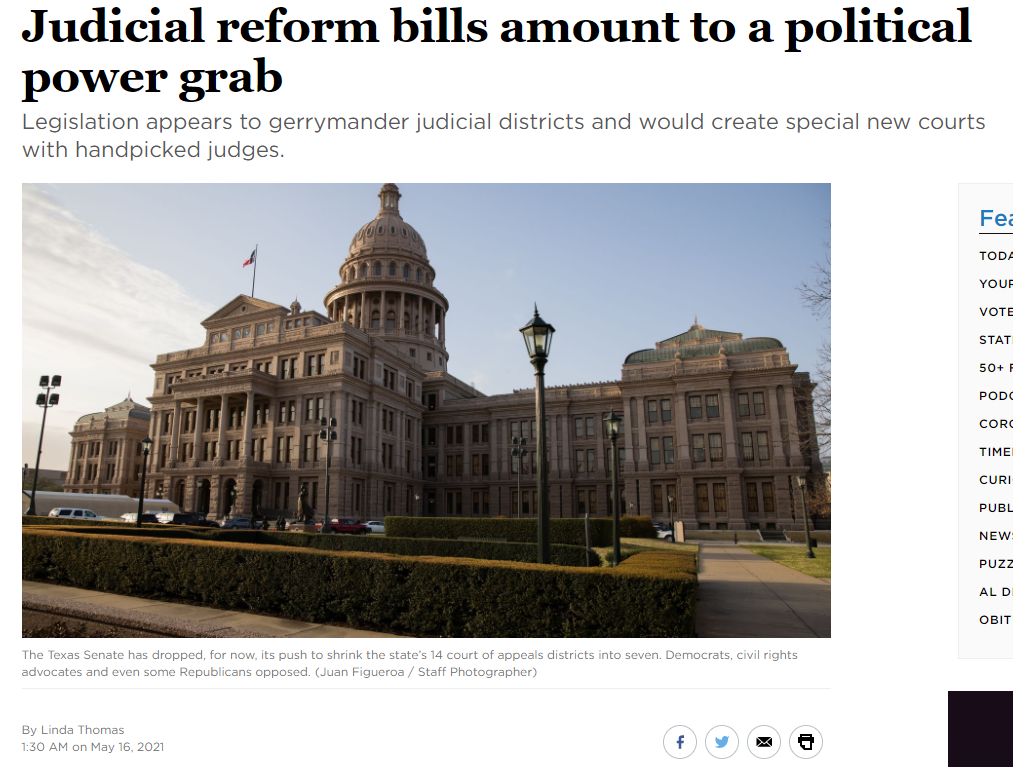 The Fifth Court’s former Chief Justice, Linda Thomas, wrote an excellent op-ed in this weekend’s Dallas Morning News about recent efforts to restructure the Texas court system.
The Fifth Court’s former Chief Justice, Linda Thomas, wrote an excellent op-ed in this weekend’s Dallas Morning News about recent efforts to restructure the Texas court system.
In JLB Builders LLC v. Hernandez, the Texas Supreme Court reversed an en banc Fifth Court opinion about a construction-site accident. The issue was the general contractor’s right of control over the workplace, and the supreme court reached these conclusions about key aspects of that issue (all emphasis added):
- Direction. “Hernandez references his additional testimony that he had previously seen JLB supervisors talking to [the subcontractor’s] foremen and that the supervisors ‘appear[ed] to be giving instructions as to how our jobs were to be done.’ Without more, evidence of what JLB generally ‘appeared’ to be doing is no evidence that it was exercising actual control over the details of the injury-causing work.”
- Safety requirements. “A general contractor that promulgates mandatory safety requirementsand procedures owes only a narrow duty to ensure that those requirements and procedures generally do not ‘unreasonably increase, rather than decrease, the probability and severity of injury.'”
- Direction. “[T]here is no indication that JLB was aware that the wind posed a particular danger that day, and the testimony that JLB employees ‘could watch’ the supports being secured is not evidence that they did so or that they were aware the supports were improperly secured.”
(In my three-part system for categorizing Texas intermediate-court en banc opinions, JLB Builders would be a “successful failure,” in that it drew supreme court attention but for the purpose of reversal.)
 Continuing the shower of spring en banc opinions from the Fifth Court, an eight-justice majority concluded that any “substantive nexus” between the relevant safety standards and health care was too attenuated to implicate the Texas Medical Liability Act on the following facts: “On May 25, 2014, Faber went to pick her mother up at Dayspring [Assisted Living Community] to take her to a hair styling appointment. Faber parked in Dayspring’s parking lot and asked a Dayspring employee to help Millie to the car. Millie, who had become a Dayspring resident only a week earlier, used a rolling walker and sat on it facing backwards as the Dayspring employee pushed her along the public sidewalk outside Dayspring’s entrance. Millie’s walker got caught in a large crack in the sidewalk, causing her to fall and hit her head on the concrete.”
Continuing the shower of spring en banc opinions from the Fifth Court, an eight-justice majority concluded that any “substantive nexus” between the relevant safety standards and health care was too attenuated to implicate the Texas Medical Liability Act on the following facts: “On May 25, 2014, Faber went to pick her mother up at Dayspring [Assisted Living Community] to take her to a hair styling appointment. Faber parked in Dayspring’s parking lot and asked a Dayspring employee to help Millie to the car. Millie, who had become a Dayspring resident only a week earlier, used a rolling walker and sat on it facing backwards as the Dayspring employee pushed her along the public sidewalk outside Dayspring’s entrance. Millie’s walker got caught in a large crack in the sidewalk, causing her to fall and hit her head on the concrete.”
 A 5-justice dissent saw otherwise: “The facts that form the basis of Faber’s suit show that Smith did not simply trip over a crack in the sidewalk. Instead, she fell because a staff member of the health care institution in which she resided pushed her over a crack in the sidewalk while she was seated in a wheeled walker causing her to fall. Because of this, Faber’s claim is inextricably intertwined with the conduct of, and duties owed by, Collin Creek as a health care provider.” Faber v. Collin Creek Assisted Living Center, No. 05-18-00827-CV (May 3, 2021).
A 5-justice dissent saw otherwise: “The facts that form the basis of Faber’s suit show that Smith did not simply trip over a crack in the sidewalk. Instead, she fell because a staff member of the health care institution in which she resided pushed her over a crack in the sidewalk while she was seated in a wheeled walker causing her to fall. Because of this, Faber’s claim is inextricably intertwined with the conduct of, and duties owed by, Collin Creek as a health care provider.” Faber v. Collin Creek Assisted Living Center, No. 05-18-00827-CV (May 3, 2021).
- In an 11-1 en banc decision written by Justice Osborne, the Fifth Court granted mandamus relief, allowing Ken Paxton to be named as a responsible third party in a securities-fraud case.
- A dissent by Justice Schenck (the lone Republican, as Justice Myers did not participate) argued that specialized comparative-fault schemes under other relevant statutes should control rather than the general comparative-fault statute.
- A concurrence by Justice Smith expressed frustration at the present rules and practices governing the sealing of court records.
In re: Cook, No. 05-20-00205-CV (April 28, 2021). (A big 600 Commerce shoutout to my friend Ben Taylor for his able assistance in reviewing these opinions).
Oral argument in the Amber Guyger appeal is at 1:00 today, it will be available to view on the Court’s Youtube channel .
.
I briefly discuss the case along with some new Supreme Court matters in an interview on KLIF this morning.
Farewell to the I-35 Court of Appeals, one of many courts that would have arisen from SB11 in this Legislative term. Fortunately, the bill’s main advocate abandoned the effort yesterday; she correctly notes that the topic of court structure is one “with many stakeholders” that should be considered in a deliberate way. 
The state Senate has undertaken the redistricting the current 14 intermediate-court districts in Texas; Law360 has a thorough story and related chart after a recent Jurisprudence Committee hearing. As for Dallas, the Senate’s plan links Austin and Dallas (right, below), cities that have been jurisprudentially distinct since at least 1893 (left, below). Please make your opinions known on the “I-35 Court of Appeals” as the Legislature continues to consider this proposal.
The Fifth Court rejected an argument that a supreme court emergency order extended the trial court’s plenary power after a case’s dismissal: “[T]he language in the emergency orders ‘giving a court the power to modify or suspend “deadlines and procedures” presupposes a pre-existing power or authority over the case or the proceedings. . . . It does not suggest that a court can create jurisdiction for itself where the jurisdiction would otherwise be absent[.]’ Here, the trial court lost jurisdiction over the case on July 20, and the motion to reinstate was not filed until November. Because the trial court lacked jurisdiction over the case by the time the motion to reinstate was filed, it could not avail itself of the emergency order to reinstate the case, and the challenged orders are void.” Quariab v. Khalili, No. 05-20-00979-CV (March 15, 2021) (mem. op.) (citing In re State ex rel. Ogg, No. WR-91,936-01, 2021 WL 800761, at *3 (Tex. Crim. App. Mar. 3, 2021)).
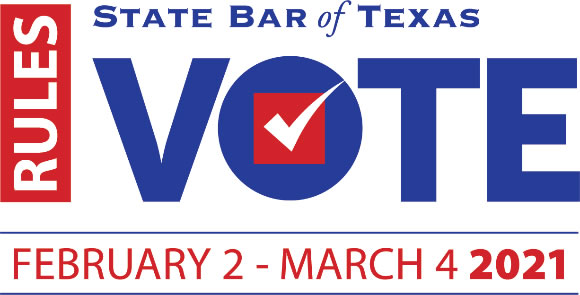 If you have power and a little time for a half-hour of ethics CLE, the State Bar Litigation Section has put together this good video about the proposed new disciplinary rules. The voting period ends March 4 and you can do that on the State Bar website.
If you have power and a little time for a half-hour of ethics CLE, the State Bar Litigation Section has put together this good video about the proposed new disciplinary rules. The voting period ends March 4 and you can do that on the State Bar website.
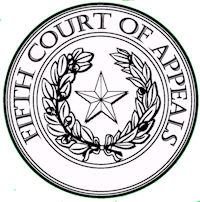 Three new Justices join the Fifth Court at the start of 2021 –
Three new Justices join the Fifth Court at the start of 2021 –
- Hon. Bonnie Lee Goldstein, who joins the Court after service since 2014 on the 44th District Court of Dallas County;
- Hon. Craig Smith, who served since 2006 on the 192nd District Court of Dallas County; and
- Hon. Dennise Garcia, who has presided over the 303rd District Court of Dallas County since 2004.
The 44th and 192nd are civil district courts and the 303rd is a family district court. When the pandemic subsides, none of the new Justices will have to change their commutes, as all three of these courts are located in the George Allen courthouse.
 A new version of Tex. R. App. P. 49.3, about motions for rehearing, takes effect at the start of 2021. The new rule addresses the problem that surfaced after the 2018 elections, when many Justices who sat on a panel were no longer on their courts when the new calendar year begin. (I am quoted in this Law360 article about the rule amendment.)
A new version of Tex. R. App. P. 49.3, about motions for rehearing, takes effect at the start of 2021. The new rule addresses the problem that surfaced after the 2018 elections, when many Justices who sat on a panel were no longer on their courts when the new calendar year begin. (I am quoted in this Law360 article about the rule amendment.)
 Yes, it’s kind of a pain, but it’s your vote, your voice, and your chance to be heard as to a widely-circulated attorney directory. The link to the Super Lawyers nomination site is here, and the deadline to make your nominations is December 21, 2020.
Yes, it’s kind of a pain, but it’s your vote, your voice, and your chance to be heard as to a widely-circulated attorney directory. The link to the Super Lawyers nomination site is here, and the deadline to make your nominations is December 21, 2020.
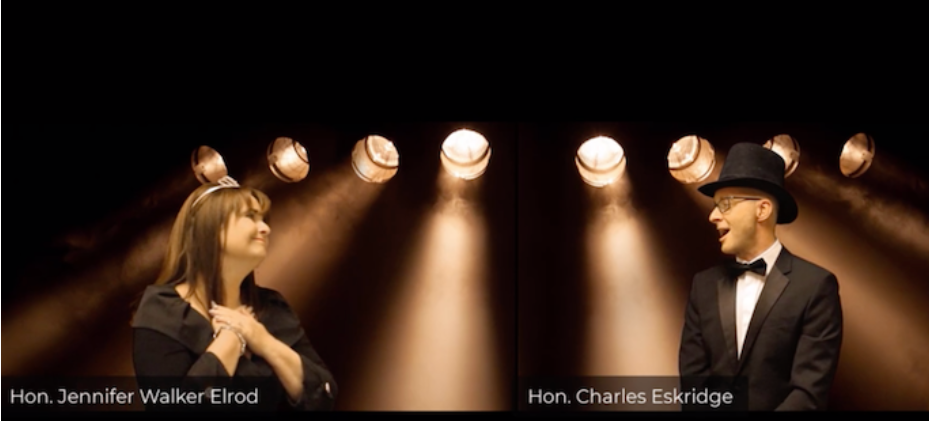 Who knew? The federal bench in Houston just released an inspiring rendition of “We’ll Be Back” from Hamilton, revised to reflect life in the COVID-19 pandemic. Bravo!
Who knew? The federal bench in Houston just released an inspiring rendition of “We’ll Be Back” from Hamilton, revised to reflect life in the COVID-19 pandemic. Bravo!
The Texas Lawbook reports (not paywalled) the intermediate court of appeals election results, with these numbers on the Dallas races with roughly 95% completion:
 The Texas Lawbook recently held a candidate forum with all of the incumbents and challengers in this year’s three races for the Fifth Court. Its report on the forum is not behind a paywall and is interesting and informative reading.
The Texas Lawbook recently held a candidate forum with all of the incumbents and challengers in this year’s three races for the Fifth Court. Its report on the forum is not behind a paywall and is interesting and informative reading.
An inartfully-drafted part of the expunction statute produced a remarkable 7-6 split of the en banc Fifth Court in Ex Parte Ferris, No. 05-19-00835-CV (Oct. 2, 2020). Charles Ferris pleaded guilty to DWI in 2015. Four years later, a jury found him not guilty in another DWI matter. Ferris sought expunction of the case in which he was acquitted, and ran headlong into a particularly awkward bit of statutory drafting.
 If his two DWI cases formed a “criminal episode” as defined by Tex. Penal Code § 3.01, he could not receive expunction. The statute defines “criminal episode” as:
If his two DWI cases formed a “criminal episode” as defined by Tex. Penal Code § 3.01, he could not receive expunction. The statute defines “criminal episode” as:
… the commission of two or more offenses, regardless of whether the harm is directed toward or inflicted upon more than one person or item of property, under the following circumstances:
(1) the offenses are committed pursuant to the same transaction or pursuant to two or more transactions that are connected or constitute a common scheme or plan; or
(2) the offenses are the repeated commission of the same or similar offenses
(emphasis added). Part (1) did not apply, so the case turned on part (2).
The majority opinion held that application of part (2) to Ferris’s two DWI cases would create an absurd result: “Such a cabined view of what constitutes a ‘criminal episode’ creates an absurd, nonsensical result wherein a single ‘criminal episode’ would engulf two DWI arrests, which (i) share no common or continuing pattern of facts; (ii) are impossible to prosecute as multiple prosecutions under Chapter 3 of the Texas Penal Code (through joinder); and (iii) could not share a concurrent sentence.” (Justice Petersen, joined  by Justices Myers, Molberg, Osborne, Reichek, Nowell, and Carlyle).
by Justices Myers, Molberg, Osborne, Reichek, Nowell, and Carlyle).
The dissent reasoned that the majority had incorrectly blurred the two parts of the statute together, “when the plain meaning of the unambiguous text of section 3.01(2): ‘criminal episode’ means the repeated commission of the same or similar offense without limitation of time, place, same or related transaction, or conspiracy.” (Justice Evans, joined by Chief Justice Burns and Justices Whitehill, Schenck, Partida-Kipness, and Browning).
In a 1981 survey of family-court judges, D Magazine memorably quoted a lawyer: “If all judges were light bulbs, Judge Annette Stewart would be a floodlight – 200 watts . . . ” The first woman to serve as a Justice of the Fifth Court recently passed away. 
The Texas Supreme Court recently entered an order amending (effective Jan. 1, 2021) several rules of civil procedure about discovery, including:
- Amendment of Tex. R. Civ. P. 47, 169, and 190 so that expedited discovery procedures will apply to any case with $250,000 or less in controversy (amended from $100,000). This also changes the Rule 47 pleading requirement.
- Rule 194 is amended to follow Fed. R. Civ. P. 26 and require initial disclosure of, among other matters,“all documents, electronically stored information, and tangible things that the responding party has in its possession, custody, or control, and may use to support its claims or defenses, unless the use would be solely for impeachment.”
Thanks to my LPHS colleague John Adams for his careful review of this order.
The Governor has directed that certain government flags fly at half-staff on August 1 in the memory of Justice Bridges.
 Long-serving Justice David Bridges was killed this weekend when his car was struck by a drunk driver. This shocking news is a loss for all North Texas.
Long-serving Justice David Bridges was killed this weekend when his car was struck by a drunk driver. This shocking news is a loss for all North Texas.
 On June 12, the Fifth Court revisited the ongoing litigation about Downtown Dallas’s much-reviled Confederate memorial, by granting the City’s emergency motion to put the memorial in “archival storage” in light of protests in the downtown area.
On June 12, the Fifth Court revisited the ongoing litigation about Downtown Dallas’s much-reviled Confederate memorial, by granting the City’s emergency motion to put the memorial in “archival storage” in light of protests in the downtown area.
 Recent orders about conducting trials during the pandemic highlight the different procedural structures of the state and federal courts.
Recent orders about conducting trials during the pandemic highlight the different procedural structures of the state and federal courts.
In the state system, the Texas Supreme Court recently released its seventeenth emergency order about when and how jury trials may resume. (An order, incidentally, that I got from the txcourts.gov website, which shows progress in returning that site to normal after the recent hacker attack.)
In the federal system, the recent order in In re Tanner reminds of the considerable district court discretion about such matters: “[T]he district court has given great consideration to the COVID-19 issues addressed by Tanner. . . . [W]hatever each of us as judges might have done in the same circumstance is not the question. Instead, as cited below, the standards are much higher for evaluating the district court’s decision” for purposes of a writ of mandamus or prohibition. No. 20-10510 (May 29, 2020).
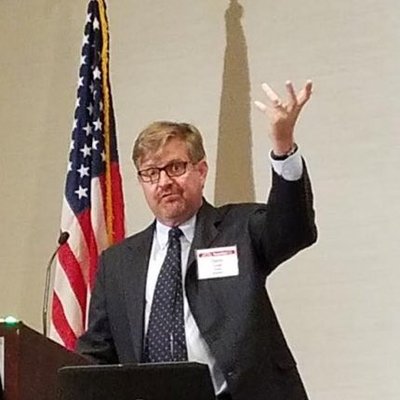 Here is the PowerPoint for my June 2 presentation to the DBA’s Appellate Law Section about Fifth Court commercial-litigation opinions over the last twelve months.
Here is the PowerPoint for my June 2 presentation to the DBA’s Appellate Law Section about Fifth Court commercial-litigation opinions over the last twelve months.
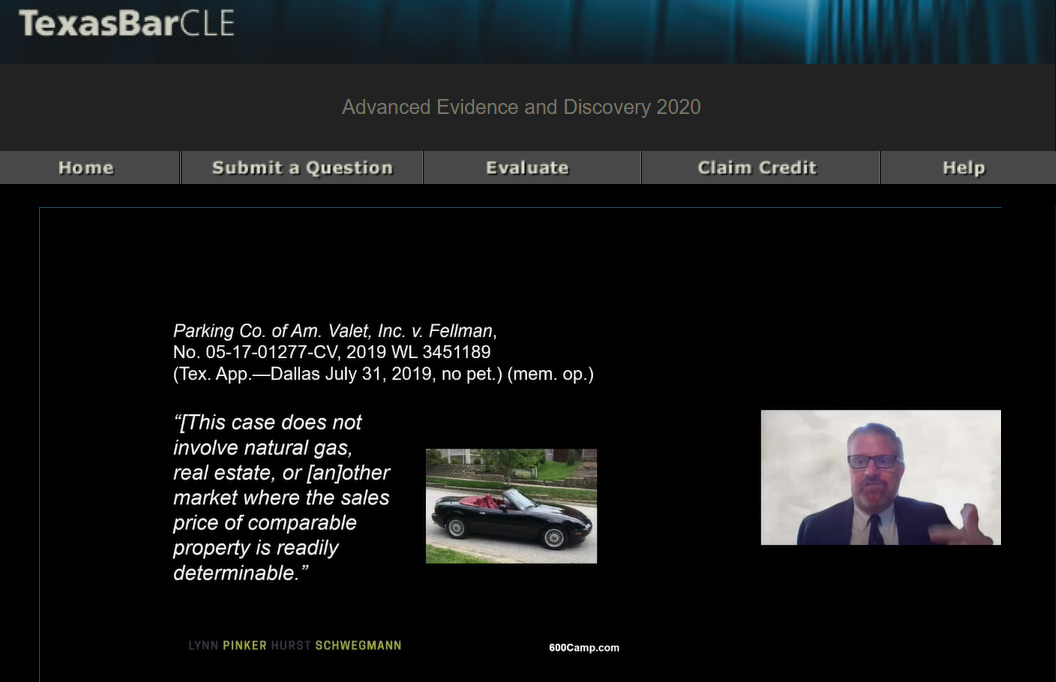 I spoke today, virtually, to the Texas Bar CLE’s 33rd “Advanced Evidence and Discovery Course,” which would have been in San Antonio. My topic was proving up damages in a commercial case, and I focused on ten specific issues identified in recent Texas and Fifth Circuit cases. I also showed off some smooth hand gestures, as you can see above. Here is a copy of my PowerPoint. The Bar staff did a terrific job with the A/V logistics and I look forward to doing another program with them soon.
I spoke today, virtually, to the Texas Bar CLE’s 33rd “Advanced Evidence and Discovery Course,” which would have been in San Antonio. My topic was proving up damages in a commercial case, and I focused on ten specific issues identified in recent Texas and Fifth Circuit cases. I also showed off some smooth hand gestures, as you can see above. Here is a copy of my PowerPoint. The Bar staff did a terrific job with the A/V logistics and I look forward to doing another program with them soon.
 The Fifth Court’s newly-released opinions are back online, with opinions accessible on a website and a new Twitter account. A press release from the Court has additional information about access while the main txcourts.gov site continues to be down. Bloggers and court observers rejoice!
The Fifth Court’s newly-released opinions are back online, with opinions accessible on a website and a new Twitter account. A press release from the Court has additional information about access while the main txcourts.gov site continues to be down. Bloggers and court observers rejoice!
 It is hard to blog about the Texas state appellate courts when their website has been the victim of a ransomware attack! The unfortunate incident has been well-covered by the Texas Lawbook and Law360. Posts on this blog will be less frequent until the situation is resolved.
It is hard to blog about the Texas state appellate courts when their website has been the victim of a ransomware attack! The unfortunate incident has been well-covered by the Texas Lawbook and Law360. Posts on this blog will be less frequent until the situation is resolved.
 The Fifth Court’s website reports: “The Fifth District Court of Appeals at Dallas has set up a YouTube channel for live streaming oral arguments held via Zoom Web Conferencing. The channel is online and open for subscriptions.”
The Fifth Court’s website reports: “The Fifth District Court of Appeals at Dallas has set up a YouTube channel for live streaming oral arguments held via Zoom Web Conferencing. The channel is online and open for subscriptions.”
The channel is available here and is a wonderful addition to public awareness and knowledge about this Court.
The key issue in Hernandez v. Sun Crane & Hoist, Inc. was whether a general contractor exercised “actual control” over a subcontractor’s work. The en banc court reversed a no-evidence summary judgment for the contractor, observing in footnote 9:
“. . . The original panel’s analysis omits any mention of (1) the Subcontract provisions described above regarding schedule control and mandatory safety harness use; (2) Johnston’s testimony that JLB supervisory employees were on-site on the day of the accident and knew the cage could fall over in the event of strong wind or improper bracing; (3) Hernandez’s testimony that he saw JLB supervisors looking at the cage’s bracing prior to the accident; and (4) Molina’s statements that the wind speed was 15–25 miles per hour on the day of the accident and Hernandez was told to jump, but was tethered to the cage by his safety harness.
Those omissions demonstrate that the original panel’s opinion represents a serious departure from precedent in the review of no-evidence summary judgment cases and therefore warrants en banc review under Texas Rule of Appellate Procedure 41.2 to ‘secure or maintain uniformity of the court’s decisions.'”
The court split cleanly along party lines, with all Democratic justices joining the majority opinion, and all Republican justices joining two dissents. Justice Bridges disagreed with the majority’s legal analysis while Justice Whitehill questioned whether the case had warranted en banc consideration. No. 05-17-00719-CV (March 26, 2020).
The estate of Billy Dickson alleged that he died from asbestos exposure at a Bell Helicopter plant. The estate won at trial on a theory of gross negligence. The panel reversed on legal sufficiency grounds, finding no evidence that Bell subjectively knew of a risk to Dickson based on his use of boards containing asbestos as part of the testing of helicopter components. Bell Helicopter Textron v. Dickson, No. 05-17-00979-CV (Aug. 23, 2019) (mem. op.) Justice Bridges wrote the opinion, joined by Justice Whitehill and then-Justice Brown.
 The full court denied en banc review on March 25. Justice Bridges signed the order, apparently joined by Justices Myers, Whitehill, Schenck, Pedersen, and Evans. Justices Molberg and Nowell did not participate.
The full court denied en banc review on March 25. Justice Bridges signed the order, apparently joined by Justices Myers, Whitehill, Schenck, Pedersen, and Evans. Justices Molberg and Nowell did not participate.
A dissent criticized the panel’s application of the City of Keller standard as not properly considering all the evidence heard by the jury, and noted : “This court has misapplied the legal sufficiency standard of review to second-guess jury verdicts before and here, it does so again.” Justice Carlyle wrote the opinion, joined by Chief Justice Burns and Justices Osborne, Partida-Kipness, and Reichek.
 A concurrence, written by Justice Whitehill and joined by all other Republican Justices on the Court (Justices Bridges, Myers, Schenck, and Evans), responded to the dissent, noting inter alia: “With no apparent bearing on the correct legal analysis of the issues in this case, the dissenting opinion (i) criticizes four prior opinions from this Court that are not asbestos cases and have no apparent logical relationship to this case . . . ”
A concurrence, written by Justice Whitehill and joined by all other Republican Justices on the Court (Justices Bridges, Myers, Schenck, and Evans), responded to the dissent, noting inter alia: “With no apparent bearing on the correct legal analysis of the issues in this case, the dissenting opinion (i) criticizes four prior opinions from this Court that are not asbestos cases and have no apparent logical relationship to this case . . . ”
To summarize, the vote was 6-5 against en banc review, largely on party lines, and would have come out differently had the two nonparticipating Justices joined their Democratic colleagues.
 The coronavirus situation has prompted review of once-obscure statutes and rules; among them, Tex. R. App. 17, which addresses where to go if the ordinarily-assigned court of appeals is unavailable. Surprisingly, Rule 17.2 sends the relevant party to the nearest alternative court of appeals, measured by distance from the trial court. For courts in the Dallas district, then, that could be Fort Worth, Waco, Tyler, or Texarkana. (To be clear, THE DALLAS COURT IS AVAILABLE, this post is just a note on a TRAP that has become less obscure in light of current events.)
The coronavirus situation has prompted review of once-obscure statutes and rules; among them, Tex. R. App. 17, which addresses where to go if the ordinarily-assigned court of appeals is unavailable. Surprisingly, Rule 17.2 sends the relevant party to the nearest alternative court of appeals, measured by distance from the trial court. For courts in the Dallas district, then, that could be Fort Worth, Waco, Tyler, or Texarkana. (To be clear, THE DALLAS COURT IS AVAILABLE, this post is just a note on a TRAP that has become less obscure in light of current events.)
A 2018 article with an LPCH colleague considered when it is wise for an intermediate appellate court, subject to further review by the Texas Supreme Court, to take issues en banc. That article has been updated on this page on this website to reflect the supreme court’s recent Flakes opinion; only time will tell whether the recent rulings and dissents by the en banc Dallas court will draw supreme court interest.
 After the 2018 election, an LPCH colleague and I wrote about the potential for renewed interest in “factual sufficiency” review–closely related to “legal sufficiency” review, but placed in the exclusive jurisdiction of the intermediate courts of appeal under the state constitution.
After the 2018 election, an LPCH colleague and I wrote about the potential for renewed interest in “factual sufficiency” review–closely related to “legal sufficiency” review, but placed in the exclusive jurisdiction of the intermediate courts of appeal under the state constitution.
An example appeared in In re C.V.L., where a panel majority reversed the termination of a parent-child relationship in a factual sufficiency review: “[E]vidence that Father used m ethamphetamines twice during the underlying proceedings and Bonds’ unsubstantiated belief that Father will use drugs again in the future because he used drugs twice in the past is not enough under a factual sufficiency review to permanently deprive Father and child of a relationship when weighed against all of the contrary, uncontroverted evidence presented at trial and the strong presumption that a child’s best interests are served by maintaining the parent–child relationship.”
ethamphetamines twice during the underlying proceedings and Bonds’ unsubstantiated belief that Father will use drugs again in the future because he used drugs twice in the past is not enough under a factual sufficiency review to permanently deprive Father and child of a relationship when weighed against all of the contrary, uncontroverted evidence presented at trial and the strong presumption that a child’s best interests are served by maintaining the parent–child relationship.”
A dissent saw the court of appeals’ role differently: “This case presents important questions regarding an appellate court’s ability to second guess a factfinder’s pivotal credibility determinations in a termination case given the supreme court’s admonition that despite the heightened standard of review in termination cases, courts of appeals must nevertheless still provide due deference to the factfinder’s credibility determinations.” No. 05-19-00506-CV (Dec. 13, 2019, pet. filed) (mem. op.)
Factual sufficiency review in this type of family-law case involves unique issues that may not arise in commercial disputes, but the case is still an important example of how this standard works in practice.
 In a dispute about arbitrability, the plaintiff claimed never to have seen the arbitration agreement, and after receiving evidence about the defendant’s computer system, the trial judge agreed.
In a dispute about arbitrability, the plaintiff claimed never to have seen the arbitration agreement, and after receiving evidence about the defendant’s computer system, the trial judge agreed.
A panel majority affirmed the denial of the motion to compel arbitration: “Aerotek made the choice to forego in-person wet-ink signatures on paper contracts. This may be a good business decision that allows it to more efficiently process more business than otherwise possible. And in this case, Aerotek made the choice to bring only one person, an employee without apparent IT experience specific to the type of computer system whose technical reliability and security she sought to vouch for. Aerotek did this in the face of admitting it had contracted out creation and implementation of this system to another entity altogether and brought no witness from that entity. We conclude Aerotek did not present evidence establishing the opposite of a vital fact, here that appellees’ denials of ever seeing the a rbitration contracts were physically impossible given Aerotek’s computer system.”
rbitration contracts were physically impossible given Aerotek’s computer system.”
A dissent had a different view of the evidence and warned that as a policy matter: “This would allow any party to a contract signed electronically to deny the existence of the contract even in the face of overwhelming evidence that the contract was signed. Further, this holding amounts to a state rule discriminating on its face against arbitration, which is expressly prohibited.”
The en banc court denied review in a brief order (Justices Molberg (the trial judge) and Whitehill did not participate); a dissent by Justice Schenck reiterated the dissent’s warnings and “urge[d] prompt review by the Texas Supreme Court.” (joined by Justices Bridges (the panel dissenter), Evans, and Myers).
In the 2018 election for a Dallas County Justice of the Peace position, Democratic candidate Margaret O’Brien obtained a default judgment that her Republican opponent, Ashley Hutcheson, was ineligible for the position because of her residence. IAfter the  election, in December 2018, a Fifth Court panel reversed, finding that the order was void because an Election Code provision bars default judgments in election cases, and further finding that the matter was not moot and required a further trial-court order because the judgment included an award of attorneys’ fees.
election, in December 2018, a Fifth Court panel reversed, finding that the order was void because an Election Code provision bars default judgments in election cases, and further finding that the matter was not moot and required a further trial-court order because the judgment included an award of attorneys’ fees.
Litigation continued before the en banc court (the makeup of which significantly changed in the same 2018 election), which ultimately settled. In a short opinion by Chief Justice Burns on March 6, 2020, a majority of the Court dismissed the case as moot and withdrew the panel opinion.
 Controversy ensued, as reflected by the four other opinions issued that day:
Controversy ensued, as reflected by the four other opinions issued that day:
- A dissent by Justice Schenck found that the matter was not moot (as it was capable
of repetition, etc.), agreed with the reasoning of the panel, and criticized the decision to withdraw the panel’s opinion (joined by Justices Bridges and Evans); - Another dissent, by Justice Whitehill, criticized the decision to withdraw the panel’s opinon for other reasons (also joined by Justice Bridges);
- A concurrence and dissent by Justice Bridges (the author of the panel opinion) agreed with the conclusion that the case is moot, disagreed with the withdrawal of the panel opinion, and reiterated the reasoning of that opinion (joined by Justices Myers, Whitehill, Schenck, and Evans — the full complement of Republican Justices on the present court);
- A concurrence by Justice Molberg clashed with the substantive reasoning of the dissents, but concluded that the order was void for another reason – ripeness – as the election had not yet occurred at the time of judgment. This opinion was joined by all other Democratic Justices on the court except Justice Pedersen, who did not participate in the case.
 “Birds of a feather flock together,” says the old proverb. But on the Fifth Court, justices of the same political party do not always rule together, as shown by two recent opinions.
“Birds of a feather flock together,” says the old proverb. But on the Fifth Court, justices of the same political party do not always rule together, as shown by two recent opinions.
The first, Inland Western v. Nguyen, No. 05-17-00151-CV (Feb. 10, 2020) began when the owners of a nail salon, the Nguyens, sued their landlord for alleged misrepresentations about lease renewal. They won a judgment in their favor after a jury trial, after which a Fifth Court panel reversed and rendered judgment for the landlord.
The Nguyens petitioned for rehearing en banc. The court granted their petition, held oral argument and then reversed course Feb. 10 in a 10-4 decision. It issued a short, form order denying en banc reconsideration without discussing the merits.
The order was supported by all five of the current Republican justices (David Bridges, Lana Myers, Bill Whitehill, David Schenck and David Evans), joined by retired Justice Robert Fillmore from the original panel. Four of the Democratic justices (Leslie Osborne, Bill Pedersen, Amanda Reichek and Cory Carlyle) also joined the order.
Three of those Republican justices joined Inland Western v. Nguyen inland concurrence that emphasized the judicial oversight of jury trials: “[Our system, like the federal, recognizes … that there is no right to a judgment on a jury verdict if the legal theory is invalid or the objective quality of the evidence does not support the jury’s finding.” Justice Schenck wrote the concurring opinion, joined by justices Bridges and Evans.
A four-justice dissent was joined by four other Democratic justices. Chief Justice Robert Burns wrote that he would remand for a new trial, noting, “Appellate courts are duty bound to indulge every reasonable inference to sustain a jury verdict when the evidence supports the verdict.” He was joined by justices Ken Molberg, Robbie Partida-Kipness and Erin Nowell.
The Nguyen opinions show the importance of party affiliation, in that all Republicans on the court joined the decision to deny review, while all the dissenting justices were Democrats. But at the same time, Nguyen reminds that the new Democratic majority on the Dallas court is not a monolithic block, as four of those justices joined the majority while four dissented.
 The second case, In re: Parks, No. 05-19-00375-CV (Feb. 18, 2020) (mem. op.), denied a mandamus petition about a trial court order striking counteraffidavits related to the reasonableness and necessity of certain medical expenses filed under Chapter 18 of the Civil Practice and Remedies Code.
The second case, In re: Parks, No. 05-19-00375-CV (Feb. 18, 2020) (mem. op.), denied a mandamus petition about a trial court order striking counteraffidavits related to the reasonableness and necessity of certain medical expenses filed under Chapter 18 of the Civil Practice and Remedies Code.
Republican Justice Bridges, joined by Democratic Justice Carlyle, drew an analogy between the trial court’s ruling and an order striking expert-witness designations, which is not ordinarily a basis for mandamus relief.
Republican Justice Schenck—who wrote the Nguyen concurrence—dissented, arguing that the present state of Dallas law “raises serious constitutional concerns related to the parties’ rights to a trial by jury, as well as their due process rights….” While from the same party as Justice Bridges, the two differed on an important procedural point about the balance of power between trial and appellate judges.
Going forward, these two cases are a good reminder that party affiliation, while important, is far from dispositive as to how a particular justice may approach a case.
(A similar article appeared this week in the Texas Lawbook. My LPCH partner Jason Dennis represents the Nguyens.)
The Committee for a Qualified Judiciary has published its list of local judicial candidates found qualified.
 The Nguyens, owners of a nail salon, sued their landlord for alleged misrepresentations related to lease renewal. They won a judgment in their favor after a jury trial; a Fifth Court panel reversed and rendered judgment for the landlord. The Court granted the Nguyens’ motion for en banc rehearing, which produced these three points of view after oral argument:
The Nguyens, owners of a nail salon, sued their landlord for alleged misrepresentations related to lease renewal. They won a judgment in their favor after a jury trial; a Fifth Court panel reversed and rendered judgment for the landlord. The Court granted the Nguyens’ motion for en banc rehearing, which produced these three points of view after oral argument:
- A majority of justices denied the request for en banc review in a short, one-line order (Justices Bridges, Myers, Whitehill, Schenck, Osborne, Pedersen, Reichek, Carlyle, Evans, and from the original panel, Justice Fillmore).
 A short concurrence underscored the importance of a judge’s power to set aside a jury verdict when required by law (Justice Schenck, joined by Justices Bridges and Evans) (as all three concurring Justices are named “David,” one
A short concurrence underscored the importance of a judge’s power to set aside a jury verdict when required by law (Justice Schenck, joined by Justices Bridges and Evans) (as all three concurring Justices are named “David,” one  could say they viewed the case in “3-D”)
could say they viewed the case in “3-D”)- Four justices dissented, emphasizing the importance of jury deliberations to the civil justice system (Chief Justice Burns, joined by Justices Molberg, Partida-Kipness, and Nowell).
No. 05-17-00151-CV (Feb. 10, 2020) (My LPCH partner Jason Dennis represented the Nguyens.)
 Last Friday’s opinion by the Texas Supreme Court in St. John Missionary Baptist Church v. Flakes reversed St. John’s Missionary Baptist Church v. Flakes, 547 S.W.3d 311 (Tex. App.–Dallas 2018) (en banc). The law of appellate briefing waiver now has (at least) these features:
Last Friday’s opinion by the Texas Supreme Court in St. John Missionary Baptist Church v. Flakes reversed St. John’s Missionary Baptist Church v. Flakes, 547 S.W.3d 311 (Tex. App.–Dallas 2018) (en banc). The law of appellate briefing waiver now has (at least) these features:
- Waiver occurs when (a) the defendants move for summary judgment on two grounds that each are an “independent basis” for judgment (limitations and release), (b) the trial court grants the motion without specifying a reason, and (c) “[o]n appeal, the plaintiff challenged the validity of the release in question but did not address the defendants’ statute-of-limitations argument.” In this situation, the trial court’s judgment “must stand, since it may have been based on a ground not specifically challenged by the plaintiff and since there was no general assignment that the trial court erred in granting summary judgment.” Malooly Bros., Inc. v. Napier, 461 S.W.2d 119 (Tex. 1970).
- Waiver does not occur when – and a court may thus request supplemental briefing if that would be helpful – when the defendants seek dismissal based on two doctrines (standing and ecclesiastical abstention), the substance of which “significantly overlaps.” The supreme court found such an “overlap” in Flakes when consideration of both doctrines required review of the applicable church bylaws and church membership situation. Two other examples cited in Flakes involve arguments about equitable relief related to points about money damages (First United Pentecostal Church v. Parker, 514 S.W.3d 214 (Tex. 2017)), and an issue about the applicability of a specific case in a broader dispute about the right to terminate a lease (Rohrmoos Venture v. UTSW DVA Healthcare, 578 S.W.3d 469 (Tex. 2019)).
- Supplemental briefing is discretionary under Flakes; cf. Horton v. Stovall, No.18-0925 (Tex. Dec. 20, 2019) (finding that an appellant should have been given the opportunity to cure the particular record-citation issues identified in that case).
 The Fifth Circuit’s recent opinion in Cutrer v. Tarrant County Local Workforce Development Board, discussed here on 600Camp, offers this fascinating tidbit about why a Texas county’s administrator is called a “county judge”:
The Fifth Circuit’s recent opinion in Cutrer v. Tarrant County Local Workforce Development Board, discussed here on 600Camp, offers this fascinating tidbit about why a Texas county’s administrator is called a “county judge”:
“The position of county judge is a remnant of Texas’s time as part of Mexico. Title II, Section VII of the 1827 Constitution of the State of Coahuila and Texas established Ayuntamientos (town councils), charged with municipal administration. And under Article 159 of the 1827 Constitution, the council was to include “Alcades.” “Alcade” is a Spanish term for a magistrate who performs both executive and judicial functions. Today, the county judge principally serves as the chief executive of a Texas county. See Tex. Const. art. V, §§ 16, 18. But in keeping with the historical pedigree of the office, a county judge still performs some judicial functions. See, e.g., Tex. Est. Code § 1002.008(a)(1); Tex. Health & Safety Code §§ 571.012, 573.012.”
A scholarly, yet highly readable article in the Texas Supreme Court Historical Society Journal by former Justice Jason Boatright offers further background on this modern-day legacy of Spanish and Mexican law.
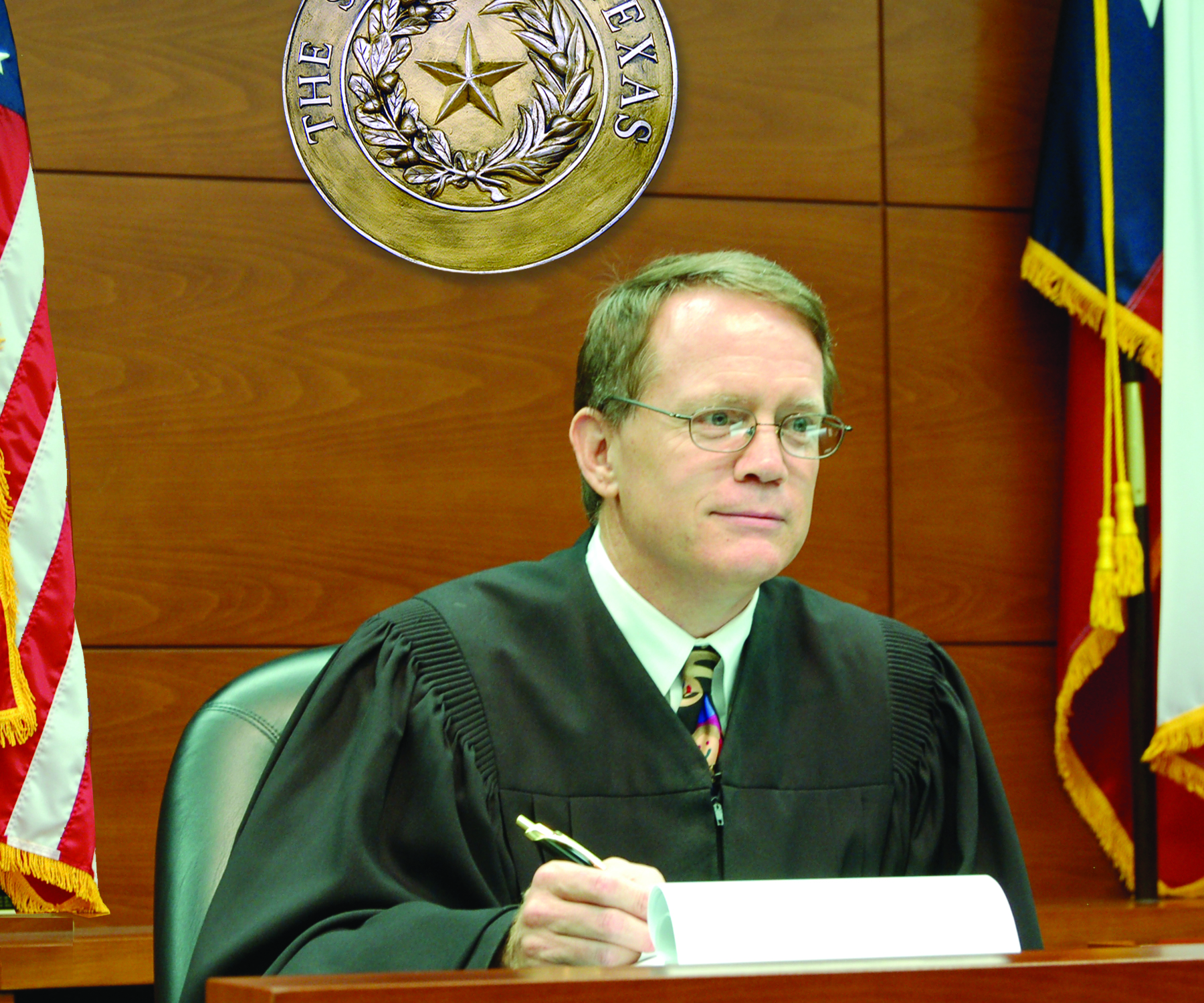 Governor Abbott has appointed Hon. David Evans to return to the Fifth Court and fill its vacant seat; Law360 reports that he may continue to hear some matters from the district court where he presently serves until his replacement is appointed and up to speed. Judge Evans recently donated a kidney to his former colleague, Hon. Carolyn Wright, an act that has raised local awareness about living organ donation. Welcome back, Justice Evans!
Governor Abbott has appointed Hon. David Evans to return to the Fifth Court and fill its vacant seat; Law360 reports that he may continue to hear some matters from the district court where he presently serves until his replacement is appointed and up to speed. Judge Evans recently donated a kidney to his former colleague, Hon. Carolyn Wright, an act that has raised local awareness about living organ donation. Welcome back, Justice Evans!
An excellent recent article in Law360 summarizes the state of the sometimes-Byzantine structure of Texas’s intermediate appellate courts. The article is behind Law360’s paywall but my remarks are below:
 “The court of appeals granted our stay motion! We’re looking good on the mandamus now!” Not necessarily, as shown by In re Gurley, No. 05-19-01118-CV (Oct. 18, 2019) (mem. op.): ” We stayed the trial court’s September 13, 2019 order granting the motion to expunge the lis pendens pending our disposition of the mandamus petition. On our request, real parties filed a response to the mandamus petition. . . . After reviewing the petition for writ of mandamus, the response filed by real parties, and the applicable law, we conclude relator
“The court of appeals granted our stay motion! We’re looking good on the mandamus now!” Not necessarily, as shown by In re Gurley, No. 05-19-01118-CV (Oct. 18, 2019) (mem. op.): ” We stayed the trial court’s September 13, 2019 order granting the motion to expunge the lis pendens pending our disposition of the mandamus petition. On our request, real parties filed a response to the mandamus petition. . . . After reviewing the petition for writ of mandamus, the response filed by real parties, and the applicable law, we conclude relator
has not shown he is entitled to the relief requested.”
The petitioner in a TCPA dispute argued that it was controlled by a previous panel opinion called Hartley, and the Fifth Court agreed. It summarized the applicable rules, very similar to the Fifth Circuit’s “rule of orderliness” –
The real parties in interest argue that Hartley is distinguishable because they present arguments and authorities that were not discussed in this Court’s opinion in Hartley. However, those arguments do not distinguish Hartley. If we agreed with those arguments, we would have to conclude Hartley was wrongly decided and must be overruled. We follow our own precedent. Dyer v. Medoc Health Servs., LLC, 573 S.W.3d 418, 427 (Tex. App.—Dallas 2019, pet. denied). “We may not overrule a prior panel decision of this Court absent an intervening change in the law by the legislature, a higher court, or this Court sitting en banc.” MobileVision Imaging Servs., L.L.C. v. LifeCare Hosps. of N. Tex., L.P., 260 S.W.3d 561, 566 (Tex. App.—Dallas 2008, no pet.). Accordingly, we adhere to our decision in Hartley.
No. 05-19-01016-CV (Sept. 23, 2019) (mem. op.).
 Today’s Dallas Morning News reports on an extraordinary act of kindness involving former Justices of the Fifth Court – Hon. David Evans is donating a kidney to Hon. Carolyn Wright. Every best wish to them both.
Today’s Dallas Morning News reports on an extraordinary act of kindness involving former Justices of the Fifth Court – Hon. David Evans is donating a kidney to Hon. Carolyn Wright. Every best wish to them both.
 Dallas-Fort Worth is the fourth largest metropolitan area in the United States, and it is only a matter of time until it passes Chicago to become #3. Dallas is routinely ranked among the nation’s best cities. Yet, as noted in a recent Texas Lawbook op-ed, it is significantly underrepresented on the Texas Supreme Court. Hopefully, geographic diversity will play a role in future appointments to that Court.
Dallas-Fort Worth is the fourth largest metropolitan area in the United States, and it is only a matter of time until it passes Chicago to become #3. Dallas is routinely ranked among the nation’s best cities. Yet, as noted in a recent Texas Lawbook op-ed, it is significantly underrepresented on the Texas Supreme Court. Hopefully, geographic diversity will play a role in future appointments to that Court.
 The panel in CKJ Trucking v. City of Honey Grove found a waiver of sovereign immunity in an unusual fact situation involving an off-duty police officer. The Fifth Court considered whether to take the matter en banc, and it appears to have fallen short by one vote. the Court’s five Republicans joined a dissent by Justice Reichek; three of whom dissented yet more in an additional opinion. No. 05-18-00205-CV (July 23, 2019 (panel), August 22, 2019 (en banc opinions).
The panel in CKJ Trucking v. City of Honey Grove found a waiver of sovereign immunity in an unusual fact situation involving an off-duty police officer. The Fifth Court considered whether to take the matter en banc, and it appears to have fallen short by one vote. the Court’s five Republicans joined a dissent by Justice Reichek; three of whom dissented yet more in an additional opinion. No. 05-18-00205-CV (July 23, 2019 (panel), August 22, 2019 (en banc opinions).
- I have an Op-Ed piece in today’s Dallas Morning News about interesting recent dissents in the Dallas Court of Appeals.
- And, I have a recent Texas Lawbook article about the en banc opinions in McPherson v. Rudman.
The panel opinion in McPherson v. Rudman affirmed a defense verdict in a medical-malpractice case. The plaintiff sought en banc review, which was denied — barely. Justice Schenck, who wrote the panel opinion, authored a strongly-written concurrence; Justice Partida-Kipness’s dissent was joined by five of the other Democratic Justices.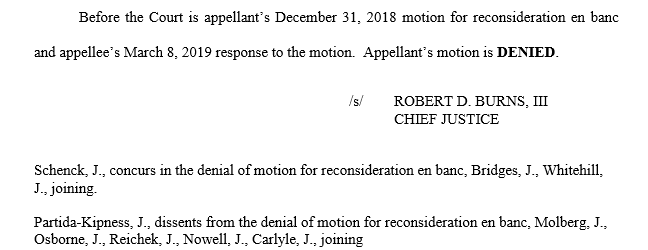
On June 28, the Texas Supreme Court denied the petition for review in Dyer v. Medoc Health Services, 573 S.W.3d 418 (Tex. App.–Dallas 2019), soldifying the foundation for several recent opinions from the Fifth Court that have limited the reach of the TCPA.
 The Texas court system has more supreme courts than the United States (2 for Texas, 1 for the USA), and more intermediate courts of appeal as well (14 for Texas, 13 for the USA). The true complexity of the Texas courts, however, lies in the sometimes-Byzantine interplay between district courts (the standard, county-wide trial court) and county courts (depending on the county, potentially “constitutional county courts,” “statutory county courts,” or “county courts at law”). An excellent example appears in Wood v. Lassiter, a dozen-page opinion about county-court jurisdiction over a dispute involving the boundary for Kaufman County road maintenance obligations. No. 05-18-01059-CV (June 28, 2019) (mem. op.)
The Texas court system has more supreme courts than the United States (2 for Texas, 1 for the USA), and more intermediate courts of appeal as well (14 for Texas, 13 for the USA). The true complexity of the Texas courts, however, lies in the sometimes-Byzantine interplay between district courts (the standard, county-wide trial court) and county courts (depending on the county, potentially “constitutional county courts,” “statutory county courts,” or “county courts at law”). An excellent example appears in Wood v. Lassiter, a dozen-page opinion about county-court jurisdiction over a dispute involving the boundary for Kaufman County road maintenance obligations. No. 05-18-01059-CV (June 28, 2019) (mem. op.)
 Here is my PowerPoint from the recent appellate course sponsored by University of Texas CLE. I also discussed this month’s opinion in In re: City of Houston, granting mandamus relief in a privilege dispute.
Here is my PowerPoint from the recent appellate course sponsored by University of Texas CLE. I also discussed this month’s opinion in In re: City of Houston, granting mandamus relief in a privilege dispute.
 Here is a copy of my PowerPoint from today. Thanks to all who came out, and to the DBA Appellate Section for the invitation!
Here is a copy of my PowerPoint from today. Thanks to all who came out, and to the DBA Appellate Section for the invitation!
 On Thursday June 13 at noon, I will speak to the DBA Appellate Law Section (and anyone else within earshot) to give an update on business law cases from the Dallas Court of Appeals in 2019. This should be a fun opportunity to look at the impact of the Slate of Eight since taking office at the start of the year. I will post the PowerPoint after the event (since it will not be done until then!)
On Thursday June 13 at noon, I will speak to the DBA Appellate Law Section (and anyone else within earshot) to give an update on business law cases from the Dallas Court of Appeals in 2019. This should be a fun opportunity to look at the impact of the Slate of Eight since taking office at the start of the year. I will post the PowerPoint after the event (since it will not be done until then!)
 600Commerce’s sister blog once described a federal appeal that became moot when, literally, the ship had sailed; a similar principle applies in a dispute about the right of possession (in Texas practice, a forcible detainer action), which becomes moot when “a writ of possession had been served on appellant” and thus “appellant is no longer in possession of [the] premises.” Jones v. Willems, No. 05-18-01191-CV (June 7, 2019). (The ship in question, since reflagged as the M/V CALHOUN, is in Singapore as of the date of this post, still well away from Fifth Circuit jurisdiction).
600Commerce’s sister blog once described a federal appeal that became moot when, literally, the ship had sailed; a similar principle applies in a dispute about the right of possession (in Texas practice, a forcible detainer action), which becomes moot when “a writ of possession had been served on appellant” and thus “appellant is no longer in possession of [the] premises.” Jones v. Willems, No. 05-18-01191-CV (June 7, 2019). (The ship in question, since reflagged as the M/V CALHOUN, is in Singapore as of the date of this post, still well away from Fifth Circuit jurisdiction).
 On May 16 at the Belo Mansion, the DBA Appellate Section presents a panel discussion among the eight newly-elected Justices of the Fifth Court of Appeals (a/k/a, the “Slate of Eight“), moderated by Justice Lana Myers, a 20-year veteran of the Fifth Court.. The Section’s announcement of the program goes on to say: “If you have a question you would like the panel to answer, please send it to DBAAppellateChair@gmail.com. The panel will try to answer pre-submitted questions during the presentation as time permits.”
On May 16 at the Belo Mansion, the DBA Appellate Section presents a panel discussion among the eight newly-elected Justices of the Fifth Court of Appeals (a/k/a, the “Slate of Eight“), moderated by Justice Lana Myers, a 20-year veteran of the Fifth Court.. The Section’s announcement of the program goes on to say: “If you have a question you would like the panel to answer, please send it to DBAAppellateChair@gmail.com. The panel will try to answer pre-submitted questions during the presentation as time permits.”
Clark sued Phillips, his former competitor in an an election for Kaufman County Commissioner, for defamation in campaign materials. Phillips lost a summary judgment motion and sought one of the many interlocutory appeals available under Texas’s Byzantine interlocutory-appeals statute; specifically, section 51.014(a)(6). The result is the second split in recent weeks between a Democratic majority and a Republican dissenter, as follows.
 Justice Reichek, joined by Justice Molberg, held that the Fifth Court lacked jurisdiction: “The record before us shows that Phillips was a candidate for public office who allegedly provided information that was published in mailers and on a website. Nothing in the record shows Phillips has ever engaged in professional news reporting or any other form of journalism or professional investigation and commentary about matters of public concern. Accordingly, Phillips does not qualify as a ‘member of the media (emphasis added),'” and thus could not avail himself of this statute.
Justice Reichek, joined by Justice Molberg, held that the Fifth Court lacked jurisdiction: “The record before us shows that Phillips was a candidate for public office who allegedly provided information that was published in mailers and on a website. Nothing in the record shows Phillips has ever engaged in professional news reporting or any other form of journalism or professional investigation and commentary about matters of public concern. Accordingly, Phillips does not qualify as a ‘member of the media (emphasis added),'” and thus could not avail himself of this statute.
Justice Whitehill, invoking Occam’s Razor, agreed with the majority’s conclusion but disagreed with the path of its reasoning: “In short, whether we have jurisdiction over Phillips’s appeal from the denial of his summary judgment motion in this defamation  case depends on whether he asserted a ground based on the First Amendment, its Texas equivalent, or Civil Practice and Remedies Code Chapter 73. He didn’t. Enough said. That should end the appeal. . . . Because there is a straightforward answer to this case without exploring in the first instance the boundaries of what constitutes the electronic media, we should follow the straightforward path and wait until when defining the electronic media is necessary to decide the case then before us (emphasis added).” Phillips v. Clark (links to both opinions above), No. 05-18-00556-CV (May 3, 2019).
case depends on whether he asserted a ground based on the First Amendment, its Texas equivalent, or Civil Practice and Remedies Code Chapter 73. He didn’t. Enough said. That should end the appeal. . . . Because there is a straightforward answer to this case without exploring in the first instance the boundaries of what constitutes the electronic media, we should follow the straightforward path and wait until when defining the electronic media is necessary to decide the case then before us (emphasis added).” Phillips v. Clark (links to both opinions above), No. 05-18-00556-CV (May 3, 2019).
Celebrate the Cinco de Mayo with 5 key Dallas court of appeals cases from 2019!
 How long is too long to rule on a pending motion? In In re Hines, it was just under seven months from the first written request for a hearing: “[R]elator’s certified mandamus record includes copies of a motion for judgment nunc pro tunc dated August 24, 2018, and letter requests to the trial court dated September 27, 2018 and November 7, 2018 requesting a hearing on the August 24, 2018 motion for judgment nunc pro
How long is too long to rule on a pending motion? In In re Hines, it was just under seven months from the first written request for a hearing: “[R]elator’s certified mandamus record includes copies of a motion for judgment nunc pro tunc dated August 24, 2018, and letter requests to the trial court dated September 27, 2018 and November 7, 2018 requesting a hearing on the August 24, 2018 motion for judgment nunc pro
tunc. The trial court has had a reasonable time in which to rule on the motion but has taken no action. Under this record, we conclude the trial court has violated its ministerial duty to rule on relator’s motion for judgment nunc pro tunc within a reasonable time.” No. 05-19-00243-CV (April 15, 2019) (mem. op.) (emphasis added).
 This coming Monday April 15 at the Belo Mansion, the Business Litigation Section presents an excellent panel discussion – “Business Appeals Before the Slate of Eight” – featuring . . . the “Slate of Eight”, the new Democratic judges elected to the Fifth Court last November. Looks like a “don’t miss” presentation.
This coming Monday April 15 at the Belo Mansion, the Business Litigation Section presents an excellent panel discussion – “Business Appeals Before the Slate of Eight” – featuring . . . the “Slate of Eight”, the new Democratic judges elected to the Fifth Court last November. Looks like a “don’t miss” presentation.
This month’s “Headnotes” from the Dallas Bar Association has two items of particular interest — on page 18, information about each of the new “Slate of Eight” Justices on the Fifth Court; and on page 19, an article by me and my LPCH colleague John Volney about the Fifth Court’s recent cases on “trial by consent.”
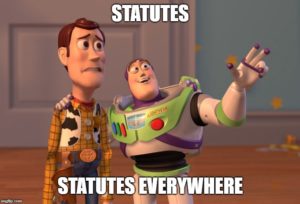 John Ellis, a former employee of DART, sued for discrimination and encountered a confoundingly complicated area of governmental-immunity law. The Fifth Court, concluding that “we are bound by controlling supreme court precedent in this area of perplexing legislative enactments,” held: “We cannot conclude in these circumstances that a waiver of governmental immunity is clear and unambiguous, as is required. Like the Norman [supreme court opinion], we view the law as ‘too internally inconsistent’ to meet that standard.” Ellis v. DART, No. 05-18-00521-CV (March 13, 2019).
John Ellis, a former employee of DART, sued for discrimination and encountered a confoundingly complicated area of governmental-immunity law. The Fifth Court, concluding that “we are bound by controlling supreme court precedent in this area of perplexing legislative enactments,” held: “We cannot conclude in these circumstances that a waiver of governmental immunity is clear and unambiguous, as is required. Like the Norman [supreme court opinion], we view the law as ‘too internally inconsistent’ to meet that standard.” Ellis v. DART, No. 05-18-00521-CV (March 13, 2019).
 My LPCH colleague John Adams and I have argued that the Fifth Court’s power to rehear cases en banc is best used for “Goldilocks” cases – issues big enough to be important in other cases, but no so important that the Texas Supreme Court is likely to preempt whatever the
My LPCH colleague John Adams and I have argued that the Fifth Court’s power to rehear cases en banc is best used for “Goldilocks” cases – issues big enough to be important in other cases, but no so important that the Texas Supreme Court is likely to preempt whatever the  Dallas court may do. In that spirit, the 13-0 opinion in Chakrabarty v. Ganguly reversed a longstanding Fifth Court precedent about whether money and stocks were “tangible personal property” within the meaning of the Family Code. No. 05-17-01195-CV (March 7, 2019).
Dallas court may do. In that spirit, the 13-0 opinion in Chakrabarty v. Ganguly reversed a longstanding Fifth Court precedent about whether money and stocks were “tangible personal property” within the meaning of the Family Code. No. 05-17-01195-CV (March 7, 2019).
The official investiture of the eight new Justices on the Fifth Court of Appeals will be at 3:30 on January 30, 2019, at the Belo Mansion in downtown Dallas.
 Together with LPCH colleagues John Adams and Paulette Miniter, I’ve written three articles about the effect of the 2018 judicial elections in three areas:
Together with LPCH colleagues John Adams and Paulette Miniter, I’ve written three articles about the effect of the 2018 judicial elections in three areas:
- Removal. “Removal to Federal Court After the November 2018 Elections:
More Incentive, But Less Receptiveness?” - Standards of Review. The Return of Factual Sufficiency Review?
- Roles of judge and jury. Three Sentences to Study: Potential New Court of Appeals Perspectives
 On January 3, the Fifth Court issued its first opinion signed by one of the newly-elected “Slate of Eight” Justices. Signed by Chief Justice Burns, it is a short memorandum opinion acknowledging the appellant’s request to dismiss the appeal, in substantially the same form that the Court has ordinarily used for such matters.
On January 3, the Fifth Court issued its first opinion signed by one of the newly-elected “Slate of Eight” Justices. Signed by Chief Justice Burns, it is a short memorandum opinion acknowledging the appellant’s request to dismiss the appeal, in substantially the same form that the Court has ordinarily used for such matters.
My LPCH colleague John Adams and I recently published a similar version of this article in the Texas Lawbook:
Newly elected judges on courts of appeals may soon find themselves at odds with the steadfastly conservative Texas Supreme Court. As the intermediate courts of appeals grapple with their role in shaping Texas jurisprudence, a firmly rooted – albeit faded – distinction between factual and legal sufficiency may return to a prominent place in appellate review. Specifically, courts of appeals may be able to limit state Supreme Court review by deciding cases based on factual sufficiency of the evidence.
This distinction between legal and factual sufficiency review is a unique feature of Texas practice. It stems from the Texas Constitution, which says that “[T]he decision of said courts [of appeals] shall be conclusive on all questions of fact brought before them on appeal or error.”
Thus, whether or not evidence is factually sufficient is a question for courts of appeals that the Texas Supreme Court cannot review.
Factual sufficiency is commonly understood to be a higher threshold than legal sufficiency, although in practice it can be difficult to distinguish the two standards. As the legal sufficiency standard has evolved toward an “inclusive” review of evidence (in other words, considering all evidence) – particularly after cases such as City of Keller v. Wilson – that standard has become less distinguishable from factual sufficiency.
Nonetheless, a distinction remains. Generally, under a factual sufficiency standard of review, a court of appeals must consider all evidence but may disregard evidence in support of a verdict if that evidence is against the clear weight and preponderance of other evidence. On the other hand, to determine legal sufficiency, a court must consider all evidence in a light favorable to the verdict – disregarding only evidence a reasonable jury couldn’t consider.
The effect of this distinction is that if a court of appeals determines that evidence is factually insufficient (although legally sufficient), the Texas Supreme Court is stuck with that decision, assuming the court of appeals applied the correct standard.
So the Texas Supreme Court cannot review whether the evidence is factually sufficient, but it can review whether the court of appeals conducted the appropriate analysis. This means the court of appeals must “detail the relevant evidence and clearly state why the evidence is factually insufficient.”
For decades, the distinction between factual and legal sufficiency has had minimal effect. The courts of appeals and the state Supreme Court have generally been in harmony about how to apply the standards of review. But for three decades, justices on the major courts of appeals and Texas Supreme Court were mostly elected from the same party with relatively low turnover.
But now, Texas has a fresh class of justices in many courts of appeals. For example, for the first time in 30 years, the Fifth Court of Appeals will be composed of mostly justices elected from the Democratic Party. Of course, many of these newly elected justices may have different perspectives from legacy state Supreme Court justices.
One way that new friction between the courts of appeals and the Texas Supreme Court may manifest is through a revitalized distinction between factual and legal sufficiency. In particular, courts of appeals may emphasize factual sufficiency to limit the Supreme Court’s review.
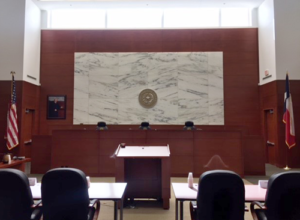 The Merrill Hartman Courtroom has been extensively remodeled for use by the Fifth Court, with space for potential visits by the Texas Supreme Court and Court of Criminal Appeals, and the Fifth Court has been using it for oral arguments throughout 2018. A rededication ceremony for that courtroom, with a reception to follow, will be held Wednesday, December 12, from 11:30 AM to 1:30 PM in the Hartman Courtroom. It is located on the 8th floor of the George Allen Courthouse at 600 Commerce in downtown Dallas.
The Merrill Hartman Courtroom has been extensively remodeled for use by the Fifth Court, with space for potential visits by the Texas Supreme Court and Court of Criminal Appeals, and the Fifth Court has been using it for oral arguments throughout 2018. A rededication ceremony for that courtroom, with a reception to follow, will be held Wednesday, December 12, from 11:30 AM to 1:30 PM in the Hartman Courtroom. It is located on the 8th floor of the George Allen Courthouse at 600 Commerce in downtown Dallas.
 In this article, my colleague Paulette Miniter and I analyze the potential effect on federal-court removals of the recent changes to the Texas state bench (elections installing Democratic majorities on the largest intermediate appellate courts) and the Fifth Circuit (several new appointments by President Trump.
In this article, my colleague Paulette Miniter and I analyze the potential effect on federal-court removals of the recent changes to the Texas state bench (elections installing Democratic majorities on the largest intermediate appellate courts) and the Fifth Circuit (several new appointments by President Trump.
“Questions of jurisdiction are questions of power,” said Supreme Court Justice Benjamin Curtis. That observation – both simple and profound – provides a useful lens to examine the sweeping changes in the Texas intermediate courts of appeal after the 2018 election. This post considers how three sentences from recent opinions by the Dallas Court of Appeals involve questions of power that may be addressed in new ways by the newly-constituted Texas appellate courts.
THREE SENTENCES
Judge and jury. The 2018 case of AVPM Corp. v. Childers involved a substantial jury verdict against a landlord, arising from a sexual assault on a tenant. The Fifth Court concluded that under the relevant Texas Supreme Court opinion, no evidence supported the verdict as to proximate causation, noting that “appellees presented no evidence at trial of any recent criminal conduct in the area of [the apartment] similar to the incident in question.” The Court agreed with the plaintiffs’ contention that “foreseeability is uniquely a fact issue for the jury and should only be set aside under the most exceptional circumstances,” but reasoned that “the analysis of foreseeability is the same for both duty and proximate cause.” Duty, of course, is generally seen as a question of law for the court rather than a jury issue. The division of power between judge and jury, as reflected in the above sentence, will likely be a topic of discussion in 2019 opinions.
Court and counsel. B.C. v. Steak & Shake, on remand from the Texas Supreme Court in 2017, turned in part on whether the trial court could consider a late-filed summary judgment response in a case about an alleged workplace assault. A 2-1 majority affirmed the trial court’s summary judgment, concluding: “We recognize, as other  courts have, the apparent injustice in allowing a no-evidence summary judgment to stand when ‘the record discloses not only that evidence exists to support the challenged element, but that the evidence was before the trial court.’ But both the language of the summary judgment rule, and the impropriety of asking the trial court to take on the nonmovant’s burden of identifying fact issues, dictates the result.”
courts have, the apparent injustice in allowing a no-evidence summary judgment to stand when ‘the record discloses not only that evidence exists to support the challenged element, but that the evidence was before the trial court.’ But both the language of the summary judgment rule, and the impropriety of asking the trial court to take on the nonmovant’s burden of identifying fact issues, dictates the result.”
The dissent would have ruled otherwise, noting that “the movant’s factual summary retold, cited, and provided the nonmovant’s testimony contradicting the motion’s assertion that there was no such evidence and further directly provided the responsive evidence.” This kind of waiver question – close even among three Justices from the same political party – may be seen differently by a new panel. And while on its face such an issue may seem hypertechnical, its resolution goes to the very definition of what issues a court should consider in the exercise of its judicial duties.
 Appeals court and trial court. In re: LaFredo arose from a divorce proceeding involving a same-sex couple; one of the parties sought a writ of mandamus on the ground that the marriage had ended before the U.S. Supreme Court’s opinion on the constitutionality of such marriages. The Fifth Court denied the petition in 2018, in part because: “ “The legal question of whether Obergefell is retroactive has not been determined by the Supreme Court of Texas or by the U.S. Supreme Court. The trial court, therefore, did not fail to correctly analyze or apply the law or reach an arbitrary and unreasonable decision when it determined that relator had not established as a matter of law that no legal marriage existed . . . .”
Appeals court and trial court. In re: LaFredo arose from a divorce proceeding involving a same-sex couple; one of the parties sought a writ of mandamus on the ground that the marriage had ended before the U.S. Supreme Court’s opinion on the constitutionality of such marriages. The Fifth Court denied the petition in 2018, in part because: “ “The legal question of whether Obergefell is retroactive has not been determined by the Supreme Court of Texas or by the U.S. Supreme Court. The trial court, therefore, did not fail to correctly analyze or apply the law or reach an arbitrary and unreasonable decision when it determined that relator had not established as a matter of law that no legal marriage existed . . . .”
Texas courts have traditionally held that a trial court lacks discretion to apply the law incorrectly. That differs from the federal practice, where the Fifth Circuit has refused to grant a writ of mandamus when a legal issue is either disputed or not settled by controlling authority and is thus not “clear.” This sentence thus suggests a willingness, even by members of an all-Republican court, to narrow this aspect of the test for when mandamus relief is appropriate. It remains to be seen whether the new court of appeals majorities will build on that suggestion – and if they do, whether the Texas Supreme Court will agree. However addressed, this seemingly-technical aspect of mandamus aspect could have a significant effect on the division of power between trial and appellate courts.
CONCLUSION
These three sentences illustrate appellate issues that seem routine and technical. They each implicate, however, basic questions about the nature and extent of judicial power. The approaches to such issues in the years ahead will be fascinating to observe and important to study.
[A version of this article ran in the Texas Lawbook in November 2018.]
The eight new Justices bring a wide range of legal experience to the Fifth Court, from the trial bench, criminal law on the prosecution and defense sides, and a variety of civil practices:
- Chief Justice, Hon. Robert Burns, presently judge of Criminal District Court 1 in Dallas County;
- Place 2, Dallas attorney Robbie Partida-Kipness, a principal in the Kipness Law Firm;
- Place 5, Dallas attorney Erin Nowell, a law partner of my former classmate Jeff Simon at Simon Greenstone & Panatier;
- Place 9, Dallas attorney Bill Pedersen, a solo with a criminal and civil law practice;
- Place 10, Dallas attorney Amanda Reichek, board-certified in labor and employment law;
- Place 11, Dallas/Rockwall attorney Cory Carlyle, who has particular expertise in criminal appeals;
- Place 12, Hon. Ken Molberg, presently judge of the 95th Civil District Court in Dallas County, whose campaign website aptly describes the Fifth Court as “the most important court you’ve never heard of“; and
- Place 13, Dallas attorney Leslie Lester Osborne, whose background is in civil litigation.
 The Fifth Court has not changed gradually; its history since its 1893 founding turns on a handful of significant changes in jurisdiction and size, most notably its expansion from six to twelve judges in 1981. One of those history-changing moments came yesterday, when voters elected eight new Justices, including a new Chief Justice. All of those new Justices are Democrats, elected to a court that has been all-Republican for many years, and creating a new Democratic majority on that Court. Every best wish to each of these new Justices as they now play their part in the history of the Fifth Court. (The Dallas Morning News provides an excellent, updated reference about these and other election returns that are not widely covered by other media.)
The Fifth Court has not changed gradually; its history since its 1893 founding turns on a handful of significant changes in jurisdiction and size, most notably its expansion from six to twelve judges in 1981. One of those history-changing moments came yesterday, when voters elected eight new Justices, including a new Chief Justice. All of those new Justices are Democrats, elected to a court that has been all-Republican for many years, and creating a new Democratic majority on that Court. Every best wish to each of these new Justices as they now play their part in the history of the Fifth Court. (The Dallas Morning News provides an excellent, updated reference about these and other election returns that are not widely covered by other media.)
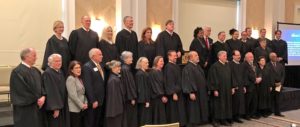 The Fifth Court celebrated its Quasquicentennial Anniversary – yes, that’s a thing, it means “125th” – at Belo yesterday. To the right is a remarkable picture of current and former Justices, as well as Chief Justice Hecht. The materials included this informative history of the court running back to its establishment in 1893.
The Fifth Court celebrated its Quasquicentennial Anniversary – yes, that’s a thing, it means “125th” – at Belo yesterday. To the right is a remarkable picture of current and former Justices, as well as Chief Justice Hecht. The materials included this informative history of the court running back to its establishment in 1893.
 Today’s Appellate CLE presentation about advocacy tips and key SCOTX cases had more sitting Justices in attendance than most appellate courts have members; it was presented by Justices Lang, Lang, Francis, Lang-Miers, Evans, Stoddart, and Boatright, with Justices Myers, Schenck, and Whitehill in attendance (as well as retired Justice Morris, and numerous staff attorneys from the Fifth Court). Here is a copy of the handout; among many items discussed:
Today’s Appellate CLE presentation about advocacy tips and key SCOTX cases had more sitting Justices in attendance than most appellate courts have members; it was presented by Justices Lang, Lang, Francis, Lang-Miers, Evans, Stoddart, and Boatright, with Justices Myers, Schenck, and Whitehill in attendance (as well as retired Justice Morris, and numerous staff attorneys from the Fifth Court). Here is a copy of the handout; among many items discussed:
- Citation – Who knew? The new Green Book for Texas case citations has eliminated the need to say “Tex. Civ. App.” for older intermediate-court opinions, standardizing all such citations with “Tex. App.”
- Don’t Get Seimed. Seim v. Allstate Texas Lloyds, 551 S.W.3d 161 (Tex. 2018), in
 clarifying the distinction between objections of “form” and those of “substance” in summary judgment practice, may have affected other lines of authority about specific types of common objections – beyond those expressly discussed in the opinion.
clarifying the distinction between objections of “form” and those of “substance” in summary judgment practice, may have affected other lines of authority about specific types of common objections – beyond those expressly discussed in the opinion.
 Dallas appellate practitioners – or anyone interested in the Fifth Court – should put these great events on their calendar for this month:
Dallas appellate practitioners – or anyone interested in the Fifth Court – should put these great events on their calendar for this month:
- Awesome CLE: “Panel Discussion with the Justices: Recent Cases Every Practitioner Should Know About and Tips for Practicing Before the Fifth District Court of Appeals at Dallas,” featuring Justices Lang, Francis, Lang-Miers, Evans, Stoddart, and Boatright. October 18, 2018, noon, at Belo.
- 125th Anniversary: Celebration of the 125th Anniversary of the Fifth Court, October 22, 2018, 3:00-5:30, at Belo. Please R.S.V.P. to Angelica Aguilar, angelica.aguilar@5th.txcourts.gov. (1893 was a busy year for court-creation; not only did the Legislature create the Fourth and Fifth Courts, but Congress created the modern version of the U.S. Court of Appeals for the D.C. Circuit).
After a Fifth Court panel reversed a plaintiff’s judgment in a premises liability case, the plaintiff’s counsel filed a motion to recuse based on campaign contributions received by two of the Justices on the panel. That motion led to an uncommon en banc opinion by the Fifth Court, which found that the motion was untimely (as it was made after receiving an adverse ruling) and lacked merit:
“Whether favored by judges or not, Texas selects its judges by popular election and requires that they finance this process. It has done so for more than a century. Recognizing this reality, Texas courts have spoken definitively and clearly with respect to the effect of campaign contributions on recusal. The mere receipt of campaign funds, in and of itself, without an indication of communication or coordination of the handling of a case, is not a basis for recusal.”
The Court then referred the plaintiff’s counsel to the State Bar for potential disciplinary action, noting that had he “ended his motion with the complaint regarding the mere receipt of campaign contributions by two justices on the panel deciding the appeal, we would deny the motion without further comment,” but instead “he has taken his disappointment with the outcome of this case to an inappropriate level by attacking the integrity of this Court . . . .” AVPM Corp. v. Childers, No. 05-17-00372-CV (revised Oct. 9, 2018) (en banc).
 Mark your calendars – the 125th Anniversary (!!!) of the Fifth Court will be celebrated soon –
Mark your calendars – the 125th Anniversary (!!!) of the Fifth Court will be celebrated soon –
- Monday, October 22, 2018
- 3:00 p.m. – 5:30 p.m.
- The Pavilion Ballroom at the Belo Mansion, downtown Dallas
Please R.S.V.P. to Angelica Aguilar by October 10th, angelica.aguilar@5th.txcourts.gov
 My LPCH colleague John Adams and I recently published “Goldilocks and the Three Outcomes: Civil En Banc Review in the Dallas Court of Appeals, 2001-18” in the Appellate Advocate, the journal of the State Bar Appellate Section. It concludes:
My LPCH colleague John Adams and I recently published “Goldilocks and the Three Outcomes: Civil En Banc Review in the Dallas Court of Appeals, 2001-18” in the Appellate Advocate, the journal of the State Bar Appellate Section. It concludes:
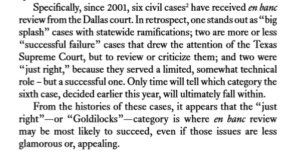
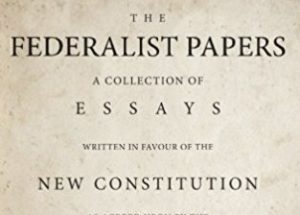 From publishing 600Camp about the Fifth Circuit, I have learned that as a result of the Erie doctrine, a substantial body of federal precedent addresses state-law issues, especially the contract and tort issues that commonly arise in homeowner wrongful foreclosure cases. Conversely, Texas courts have created a body of state authority about federal-law issues. Neither system’s intermediate court opinions bind the other, leading occasionally to a case like Osadon v. C&N Renovation Inc., in which the Dallas Court of Appeals declined to follow a Fifth Circuit opinion on a point of bankruptcy law, concluding (along with several other courts outside the Circuit) that the text of the relevant Code section dictated a different result. No. 05-17-00453-CV (May 9, 2018) (mem. op.)
From publishing 600Camp about the Fifth Circuit, I have learned that as a result of the Erie doctrine, a substantial body of federal precedent addresses state-law issues, especially the contract and tort issues that commonly arise in homeowner wrongful foreclosure cases. Conversely, Texas courts have created a body of state authority about federal-law issues. Neither system’s intermediate court opinions bind the other, leading occasionally to a case like Osadon v. C&N Renovation Inc., in which the Dallas Court of Appeals declined to follow a Fifth Circuit opinion on a point of bankruptcy law, concluding (along with several other courts outside the Circuit) that the text of the relevant Code section dictated a different result. No. 05-17-00453-CV (May 9, 2018) (mem. op.)
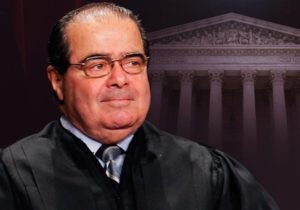 In a rare en banc decision, a majority of Fifth Court justices held in St. John Missionary Baptist Church v. Flakes that “construing [Tex. R. App. P] 38.9(b) to require us to identify and suggest briefing on issues not raised by an appellant would depart from our duty to be neutral and impartial.” Thus, in the case before it: “Because appellants fail to challenge all grounds upon which the trial court could have granted appellees’ amended motion to dismiss and plea to the jurisdiction, we have no discretion to do anything other than to accept the validity of the unchallenged ground.” Two dissents countered that “where the parties have in fact preserved the issues below, timely appealed, and identified the issues for a decision on appeal, a brief that fails to adequately cite to authority or the record, or that omits an argument that is deemed to be included in the trial court’s disposition of the issue, should not be fatal to the appeal. Instead, that deficiency simply amounts to ‘a failure to properly present the case on the briefs’ and affords the court a number of efficient options under the rules.” No. 05-16-00671-CV (March 29, 2018).
In a rare en banc decision, a majority of Fifth Court justices held in St. John Missionary Baptist Church v. Flakes that “construing [Tex. R. App. P] 38.9(b) to require us to identify and suggest briefing on issues not raised by an appellant would depart from our duty to be neutral and impartial.” Thus, in the case before it: “Because appellants fail to challenge all grounds upon which the trial court could have granted appellees’ amended motion to dismiss and plea to the jurisdiction, we have no discretion to do anything other than to accept the validity of the unchallenged ground.” Two dissents countered that “where the parties have in fact preserved the issues below, timely appealed, and identified the issues for a decision on appeal, a brief that fails to adequately cite to authority or the record, or that omits an argument that is deemed to be included in the trial court’s disposition of the issue, should not be fatal to the appeal. Instead, that deficiency simply amounts to ‘a failure to properly present the case on the briefs’ and affords the court a number of efficient options under the rules.” No. 05-16-00671-CV (March 29, 2018).
The majority opinion was written by Justice Evans, joined by Chief Justice Wright and Justices Francis, Lang, Lang-Miers, Brown, Stoddart, and Whitehill. The dissenters were Justices Schenck, Bridges, Fillmore, Myers, and Boatright (who also wrote a separate, individual dissent). The division of opinion in this case offers a rare insight on how the viewpoints of the Justices compare on a waiver issue; a general topic frequently addressed by the Fifth Court in a variety of different settings.
 The primary results are in, and the November ballot for the eight open slots on the Fifth Court will be as follows. (The Texas Lawbook recently analyzed the election and the unusually large number of contested seats).
The primary results are in, and the November ballot for the eight open slots on the Fifth Court will be as follows. (The Texas Lawbook recently analyzed the election and the unusually large number of contested seats).
Chief Justice: Doug Lang (R) v. Robert Burns (D)
Place 2: David Evans (R) v. Robbie Partida-Kipness (D)
Place 5: Craig Stoddart (R) v. Erin Nowell (D)
Place 9: Jason Boatright (R) v. Bill Pedersen (D)
Place 10: Molly Francis (R) v. Amanda Reichek (D)
Place 11:John Browning (R) v. Cory Carlyle (D)
Place 12: Winner of runoff between Jim Pikl and William “Randy” Johnson (R) v. Ken Molberg (D)
Place 13: Elizabeth Lang-Miers (R) v. Leslie Lester Osborne (D)
 The 2018 results are available from the Committee for a Qualified Judiciary for Dallas-area judicial races.
The 2018 results are available from the Committee for a Qualified Judiciary for Dallas-area judicial races.
 The Fifth Court’s website reports: “On January 30, 2018, the Fifth Court of Appeals held inaugural oral arguments in the historic Dallas County Merrill Hartman Courtroom located on the 8th Floor of the George Allen Sr. Courts Building [right]. Thanks to a joint effort between the Dallas County Commissioners, the Dallas District Courts, and the Fifth Court of Appeals, the Merrill Hartman Courtroom’s judicial bench was redesigned to accommodate the 13 appellate court justices in en banc settings as well as 3 member panels. The Fifth Court of Appeals also serves as the disaster recovery site for the nine member Texas Supreme Court. Both appellate courts, and district courts will utilize the courtroom. Upon final completion of renovations, a re-dedication ceremony is planned on a date to be determined in April 2018.”
The Fifth Court’s website reports: “On January 30, 2018, the Fifth Court of Appeals held inaugural oral arguments in the historic Dallas County Merrill Hartman Courtroom located on the 8th Floor of the George Allen Sr. Courts Building [right]. Thanks to a joint effort between the Dallas County Commissioners, the Dallas District Courts, and the Fifth Court of Appeals, the Merrill Hartman Courtroom’s judicial bench was redesigned to accommodate the 13 appellate court justices in en banc settings as well as 3 member panels. The Fifth Court of Appeals also serves as the disaster recovery site for the nine member Texas Supreme Court. Both appellate courts, and district courts will utilize the courtroom. Upon final completion of renovations, a re-dedication ceremony is planned on a date to be determined in April 2018.”
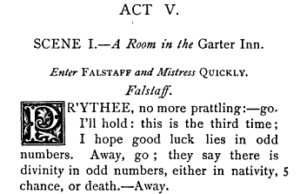 B.C. v. Steak & Shake involved a late-filed summary judgment response. The unsuccessful appellant sought rehearing en banc, which led to another opinion. Among other matters, the Court declined to consider a “supplemental clerk’s record” containing information about the logistics of the filing, when that material was not before the trial court or the Fifth Court at the time of its opinion. The Court quoted Chief Justice Hecht’s statement on the general subject in Worthy v. Collagen Corp., 967 S.W.2d 360, 366 Tex. 1998): “Supplementation of the record after a case is decided is a different matter. It certainly does not serve judicial economy for the appellate court to allow a supplementation of the record that would require it to reconsider its decision on the merits when the party has had ample opportunity to correct the omission prior to decision.” 967 S.W.2d 360, 366 (Tex. 1988). No. 05-14-00649-CV (Oct. 27, 2017) (suppl. op. on rehearing).
B.C. v. Steak & Shake involved a late-filed summary judgment response. The unsuccessful appellant sought rehearing en banc, which led to another opinion. Among other matters, the Court declined to consider a “supplemental clerk’s record” containing information about the logistics of the filing, when that material was not before the trial court or the Fifth Court at the time of its opinion. The Court quoted Chief Justice Hecht’s statement on the general subject in Worthy v. Collagen Corp., 967 S.W.2d 360, 366 Tex. 1998): “Supplementation of the record after a case is decided is a different matter. It certainly does not serve judicial economy for the appellate court to allow a supplementation of the record that would require it to reconsider its decision on the merits when the party has had ample opportunity to correct the omission prior to decision.” 967 S.W.2d 360, 366 (Tex. 1988). No. 05-14-00649-CV (Oct. 27, 2017) (suppl. op. on rehearing).








